#philadelphia based artist
Text
kokeshi doll but of arakawa durin his theater days......... do we know what i mean.......
#snap chats#i looove kokeshi dolls so much... my dad bought me one during a trip toooo#new york ? i think ? maybe it was philadelphia.... some east-coast city like that#i cant remember i just know we were walking around and we passed by this little japanese stand#and my dad bought me a kokeshi doll and i loved it so much..#it was mostly beige with white hair and was decorated with red flowers and had a sort of rigged body#i remember i kept the box too and i put this old metal and ceramic hair pin in there#but i those at my dad's one day so now it's lost to storage since he moved a lot. amongst a bunch of my other stuff LMAO#i should prob ask about that someday... but anyway let me continue this post...#but yeah anyway.... for context... kokeshi dolls are As They Sound little wooden dolls#they're typically designed with the influence of the artist's hometown in mind but they can also be based off of celebrities#so... legally... arakawa could have been a candidate to have a kokeshi doll... in my opinion...#at the very least maybe there was a big ol fan of his out there that felt like making a doll or somethin#i just know i miss my doll.. now all i have is my kokeshi tea set. its cute tho so im not mad#speaking of tea i drank two tea bowl's worth of matcha to hopefully keep me awake so i could work#but i feel laggard but Not Sleepy so i cant really muster up the direction to work on comms.. oops..#im gonna try tho lemme end this post bye
4 notes
·
View notes
Text
NASA Inspires Your Crafty Creations for World Embroidery Day
It’s amazing what you can do with a little needle and thread! For #WorldEmbroideryDay, we asked what NASA imagery inspired you. You responded with a variety of embroidered creations, highlighting our different areas of study.
Here’s what we found:
Webb’s Carina Nebula
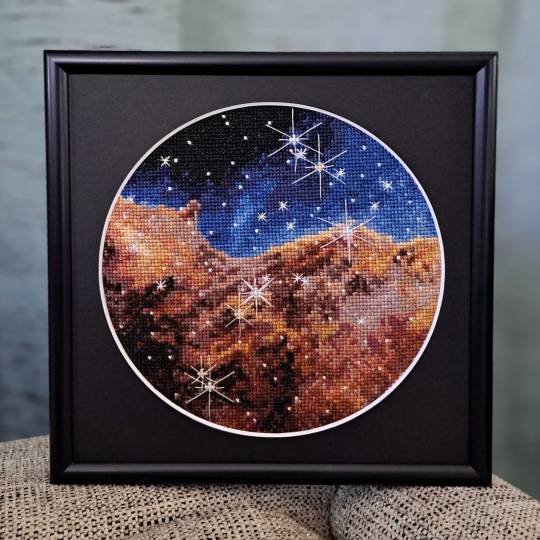
Wendy Edwards, a project coordinator with Earth Science Data Systems at NASA, created this embroidered piece inspired by Webb’s Carina Nebula image. Captured in infrared light, this image revealed for the first time previously invisible areas of star birth. Credit: Wendy Edwards, NASA. Pattern credit: Clare Bray, Climbing Goat Designs
Wendy Edwards, a project coordinator with Earth Science Data Systems at NASA, first learned cross stitch in middle school where she had to pick rotating electives and cross stitch/embroidery was one of the options. “When I look up to the stars and think about how incredibly, incomprehensibly big it is out there in the universe, I’m reminded that the universe isn’t ‘out there’ at all. We’re in it,” she said. Her latest piece focused on Webb’s image release of the Carina Nebula. The image showcased the telescope’s ability to peer through cosmic dust, shedding new light on how stars form.
Ocean Color Imagery: Exploring the North Caspian Sea
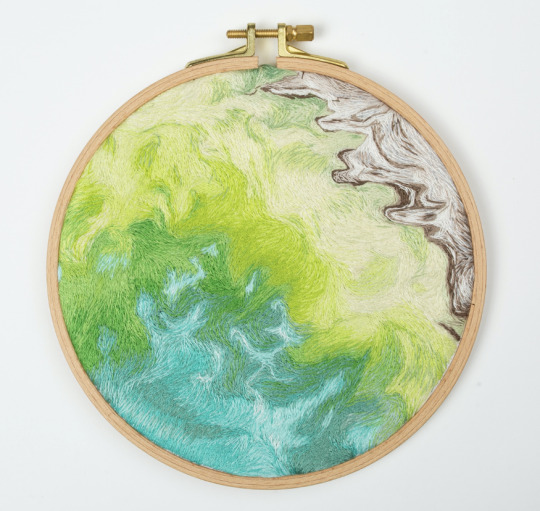
Danielle Currie of Satellite Stitches created a piece inspired by the Caspian Sea, taken by NASA’s ocean color satellites. Credit: Danielle Currie/Satellite Stitches
Danielle Currie is an environmental professional who resides in New Brunswick, Canada. She began embroidering at the beginning of the Covid-19 pandemic as a hobby to take her mind off the stress of the unknown. Danielle’s piece is titled “46.69, 50.43,” named after the coordinates of the area of the northern Caspian Sea captured by LandSat8 in 2019.

An image of the Caspian Sea captured by Landsat 8 in 2019. Credit: NASA
Two Hubble Images of the Pillars of Creation, 1995 and 2015

Melissa Cole of Star Stuff Stitching created an embroidery piece based on the Hubble image Pillars of Creation released in 1995. Credit: Melissa Cole, Star Stuff Stitching
Melissa Cole is an award-winning fiber artist from Philadelphia, PA, USA, inspired by the beauty and vastness of the universe. They began creating their own cross stitch patterns at 14, while living with their grandparents in rural Michigan, using colored pencils and graph paper. The Pillars of Creation (Eagle Nebula, M16), released by the Hubble Telescope in 1995 when Melissa was just 11 years old, captured the imagination of a young person in a rural, religious setting, with limited access to science education.

Lauren Wright Vartanian of the shop Neurons and Nebulas created this piece inspired by the Hubble Space Telescope’s 2015 25th anniversary re-capture of the Pillars of Creation. Credit: Lauren Wright Vartanian, Neurons and Nebulas
Lauren Wright Vartanian of Guelph, Ontario Canada considers herself a huge space nerd. She’s a multidisciplinary artist who took up hand sewing after the birth of her daughter. She’s currently working on the illustrations for a science themed alphabet book, made entirely out of textile art. It is being published by Firefly Books and comes out in the fall of 2024. Lauren said she was enamored by the original Pillars image released by Hubble in 1995. When Hubble released a higher resolution capture in 2015, she fell in love even further! This is her tribute to those well-known images.
James Webb Telescope Captures Pillars of Creation

Darci Lenker of Darci Lenker Art, created a rectangular version of Webb’s Pillars of Creation. Credit: Darci Lenker of Darci Lenker Art
Darci Lenker of Norman, Oklahoma started embroidery in college more than 20 years ago, but mainly only used it as an embellishment for her other fiber works. In 2015, she started a daily embroidery project where she planned to do one one-inch circle of embroidery every day for a year. She did a collection of miniature thread painted galaxies and nebulas for Science Museum Oklahoma in 2019. Lenker said she had previously embroidered the Hubble Telescope’s image of Pillars of Creation and was excited to see the new Webb Telescope image of the same thing. Lenker could not wait to stitch the same piece with bolder, more vivid colors.
Milky Way

Darci Lenker of Darci Lenker Art was inspired by NASA’s imaging of the Milky Way Galaxy. Credit: Darci Lenker
In this piece, Lenker became inspired by the Milky Way Galaxy, which is organized into spiral arms of giant stars that illuminate interstellar gas and dust. The Sun is in a finger called the Orion Spur.
The Cosmic Microwave Background
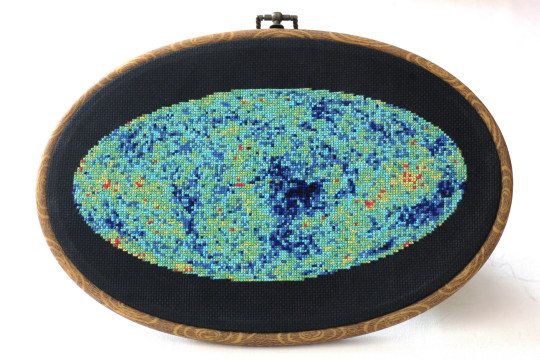
This image shows an embroidery design based on the cosmic microwave background, created by Jessica Campbell, who runs Astrostitches. Inside a tan wooden frame, a colorful oval is stitched onto a black background in shades of blue, green, yellow, and a little bit of red. Credit: Jessica Campbell/ Astrostitches
Jessica Campbell obtained her PhD in astrophysics from the University of Toronto studying interstellar dust and magnetic fields in the Milky Way Galaxy. Jessica promptly taught herself how to cross-stitch in March 2020 and has since enjoyed turning astronomical observations into realistic cross-stitches. Her piece was inspired by the cosmic microwave background, which displays the oldest light in the universe.

The full-sky image of the temperature fluctuations (shown as color differences) in the cosmic microwave background, made from nine years of WMAP observations. These are the seeds of galaxies, from a time when the universe was under 400,000 years old. Credit: NASA/WMAP Science Team
GISSTEMP: NASA’s Yearly Temperature Release

Katy Mersmann, a NASA social media specialist, created this embroidered piece based on NASA’s Goddard Institute for Space Studies (GISS) global annual temperature record. Earth’s average surface temperature in 2020 tied with 2016 as the warmest year on record. Credit: Katy Mersmann, NASA
Katy Mersmann is a social media specialist at NASA’s Goddard Space Flight Center in Greenbelt, Md. She started embroidering when she was in graduate school. Many of her pieces are inspired by her work as a communicator. With climate data in particular, she was inspired by the researchers who are doing the work to understand how the planet is changing. The GISTEMP piece above is based on a data visualization of 2020 global temperature anomalies, still currently tied for the warmest year on record.
In addition to embroidery, NASA continues to inspire art in all forms. Check out other creative takes with Landsat Crafts and the James Webb Space telescope public art gallery.
Make sure to follow us on Tumblr for your regular dose of space!
#NASA#creativity#fiber art#embroidery#art#art challenge#needlework#crafts#handmade#textile art#cross stitch#stitching#inspiration#inspo#Earth#Earth science#Hubble#James Webb Space Telescope#climate change#water#nebula#stars
6K notes
·
View notes
Text
Okay, I guess this is my Writeblr intro!
Pretty new to this, so here goes nothing...
Greetings, Writeblr!
My name's Chris (he/him), I'm 27, currently based in Philadelphia. I'm a visual artist, specializing in 2D media and illustration, and I'm also an avid lover of Fiction and Storytelling!
Naturally, the sum of these interests manifests itself as a love for Comics and Sequential Art; with that being said, the majority of my Fiction Writing is for comics and graphic novels.
I started my journey in learning to write fiction a few years ago; i always had a love for Story, whether it be books, shows, comics, movies.... if there's a Compelling Narrative and Compelling Characters, chances are I'm all over it!
My current WIP is a Sci-Fi, Cosmic Horror, Sports Drama Graphic novel series, called OneFall: a Dystopian, Cyberpunk world of Lovecraftian horror, compounded with the action-packed, fast-paced world of Pro-Wrestling, injected with themes of identity, feminism, revolution, and reconciling with past trauma. If this sounds like an interesting (albeit unorthodox) combination, then maybe this comic is for you!
As you might've guessed, I tend to write (and read) in the genres of Action-Adventure, Sci-fi, and Horror, but I tend to dip my feet in whatever catches my interest.
While I'm no stranger to this site, I'm fairly new to this neck of the woods, so... feel free to say hi!
Where my fellow writers at?
#writeblr#comics#artist#writing#creative writing#writing comics#fiction#writing fiction#writers on tumblr#writerscommunity#pro wrestling#pro wrestling women#womens wrestling#graphic novel#on writing#writeblr intro#putting myself out there#looking to connect with some more writers
59 notes
·
View notes
Text
Mattea Murdock, the Daredevil Drummer of Philly
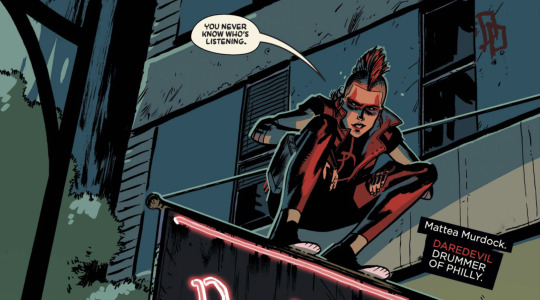
In celebration of the forthcoming new Spider-Punk: Arms Race series (not to mention Hobie stealing scenes in "Across the Spider-Verse" last year), I wanted to finally write up my long-overdue overview post on Mattea Murdock! If you haven't read her introductory run yet, check it out here.
Mattea truly stands on her own in the wide canon of alternate universe DDs. She is a female Daredevil, she is Latina, and she somehow managed to escape Marvel's NYC gravity and base herself in Philadelphia, where she defends its citizens from violence and exploitation. Hobie and his self-styled Spider-Band encounter her in Spider-Punk (2022) #3, when they make a detour to fix the busted Spider-Van. They are all immediately-- and correctly-- impressed.

Mattea: "Yo, Kam!"
Hobie: "Wait, you know each other?!"
Kamala: "Duh! You think I wouldn't know the Daredevil Drummer of Philly?"
Hobie: "You're a drummer too?"
Mattea: "Best in town."
Hobie: "Oh man, my friend Gwen is a pretty dope drummer too. I think y'all would definitely get along."
Mattea: "Hope they're ready to get outplayed by a pretty, blind girl."
Spider-Punk vol. 1 #3 by Cody Ziglar, Justin Mason, Jim Charalampidis, and Travis Lanham
I talked a little about her killer character/costume design when she was first introduced (I was a fool; of course she's blind), and my love for her look has only grown. It's badass, distinctive, and it slots her beautifully into Hobie's punk rock world while still evoking that trademark Daredevil image (red, sticks, pointy bits...). Her irises are red, which is a visual choice I enjoy in more heightened, fantastical DD stories/art styles, and I think it works for Mattea. Heck, I could even imagine them being colored contact lenses she's chosen to wear for the aesthetic. Also, one detail that wasn't in the previews is the fun little laughing devil face on the back of her jacket (I'm not punk rock enough to get the reference if it is one, but it reminds me of Darkdevil):

Of course, always a big priority for me is Daredevil's power-set, and Mattea provides a quick primer on her unique perspective, mostly focused on hearing and the radar sense:
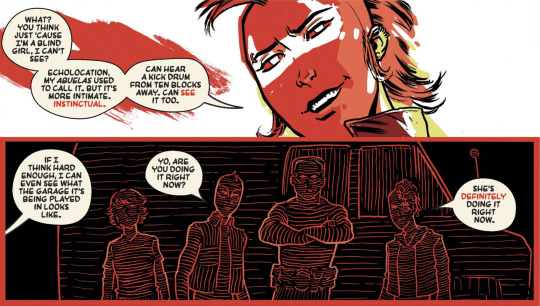
Mattea: "What? You think just 'cause I'm a blind girl, I can't see? Echolocation, my abuelas used to call it. But it's more intimate. Instinctual. Can hear a kick drum from ten blocks away. Can see it too. If I think hard enough, I can even see what the garage it's being played in looks like."
Hobie: "Yo, are you doing it right now?"
Riri: "She's definitely doing it right now."
This is not my favorite description of Daredevil's powers, nor-- to be honest-- a particularly informative one. She can gather spatial information through walls...from ten blocks away? I also never love an overuse of visual language in any explanation of these powers, especially as it's implied that Mattea, like Matt, is completely blind. Surprisingly, no direct mention is made here of the hypersenses as a whole, beyond the reference to hearing a kick drum from ten blocks away. Even her hearing doesn't receive that much attention in the story overall, which feels like a missed opportunity for such a musical character. Her blindness, too, is pretty much irrelevant to the story, and never comes up again. But I do LOVE that she uses the term "echolocation", though is still very clearly the radar sense, in all its vague, undefined, semi-magic glory.
And visually? This is great. I'm always a fan of the cross-hatching visual, especially against a black background, and artist Justin Mason doesn't go too overboard on the detail, which is another preference of mine. And thematically, I love the ways in which Mattea's drummer identity is tied into her superheroics-- not just for laying a beatdown on bad guys, but also for channelling and enhancing her echolocation/radar sense. One of my favorite scenes in the comic is when she plays a drum solo on a roof edge to scope out the Kingpin's lair. I'm willing, in that moment, to ignore any gripes about radar sense irregularities out of respect for the coolness and thematic heft of the concept. I mean, this rocks:

Mattea: "Come on, show me the good stuff."
At the end of the day, though, this is not a Daredevil comic and Mattea is not the main character. Plus, it's only five issues long, and introduces a bunch of other new characters as well. There was only ever going to be room for the creative team to offer a cursory introduction, hopefully generating enough interest to prompt these characters to appear again in other comics. In that, I think they fully succeeded with Mattea; we get a cursory sense of her powers (or at least, enough to show that they're the normal DD set), her personality (delightfully cocky, playful, tough, fearless), a few hints of her backstory, and some truly kickass fight scenes. There's a bit of suspension of disbelief required to believe she can use drumsticks as a stand-in for billy clubs (unless her drumsticks are made of something really hefty-- and hey, maybe they are), but this is Spider-Punk. Hobie killed Norman Osborn with a guitar--twice. It's not about realism, it's about style.

Mattea: "Been waiting for this for a long time, Fisk. Real long time."
Fisk: "I'm going to break you, li'l girl--AWGGH!"
Mattea: "Big, strong man who sends out his band of wackos to push over people too weak to fight back."
Fisk: "Wouldn't get too cocky, girlie...you're not the only one who's fast! I'm gonna hurt ya. A lot. Then I'm gonna kill ya. And I'm gonna love every second of it. You know, this is the same look you had when I had your old band clapped a few years back. I like it. Brings out your eyes--GAAAH!"
Mattea: "There's something you need to understand about me, papi. I'm not the kinda girl who goes down without a fight."
I can't wait to see more of Mattea and learn more about her, her world, her friends, and her enemies. In particular, she seems to have a history (possibly romantic?) with this world's Kamala Khan, and I would love to see more of that relationship. While Mattea Murdock clearly has a lot in common with Matt Murdock, she also seems happy to be a team player, unlike Matt, and I really enjoy that. Though I guess it's not that surprising a distinction. After all, every drummer needs a band.

#Spider-Punk vol. 1#Daredevil#Mattea Murdock#Spider-Punk#Hobie Brown#Spider-Band#Commentary#ID in alt text
60 notes
·
View notes
Photo
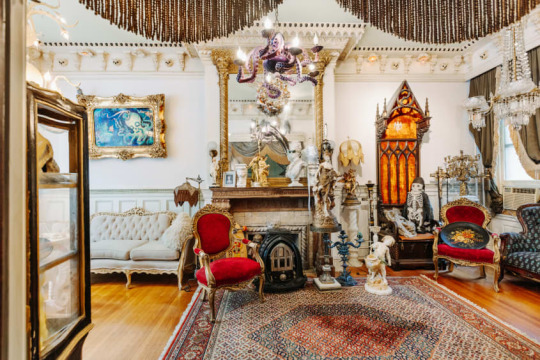

It’s time to revisit photographer turned novelty chandelier maker, Adam Wallacavage’s Philadelphia, Pennsylvania 1890 brownstone, b/c it celebrates spooky season all year.

Before he purchased his home, he lived in a tiny apartment across the street from famed stained glass artist Judith Schaechter. Her house was his original inspiration.
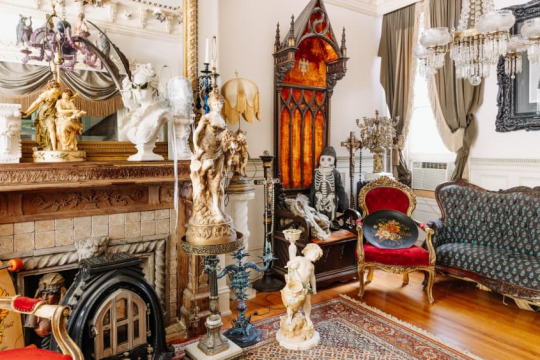

From there, he graduated to making sculptural lighting, then showing at the Jonathan LeVine gallery in NYC and all over the world.
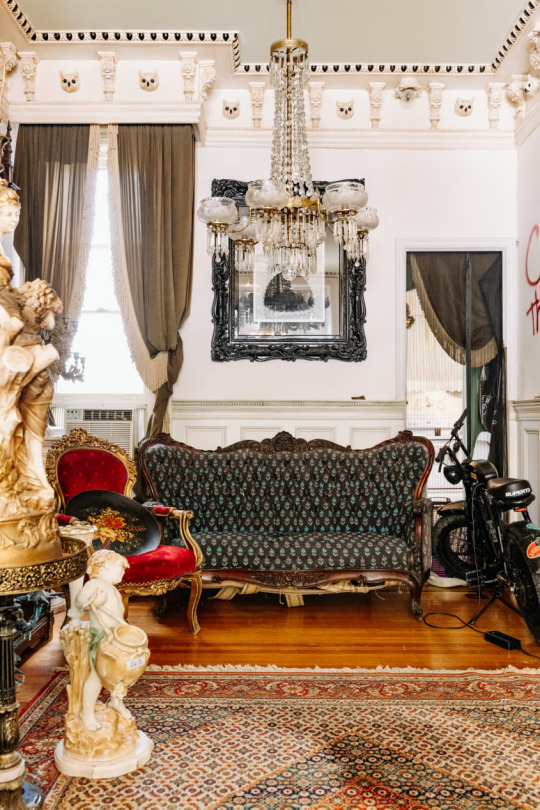
Unlike Judith’s house, Adam’s was missing all the ornamental elements as it was modernized in the 1940s. It was dirt cheap, so he didn’t have a place worth restoring but a place worth customizing.

He tore down walls and rebuilt the layout similar to the original design, making molds and casting plaster and turning the place into a Victorian style freak show.

After visiting the Royal Pavilion in Brighton, United Kingdom just a few months after closing on the house, he found his path to what he wanted his interior to be based on.
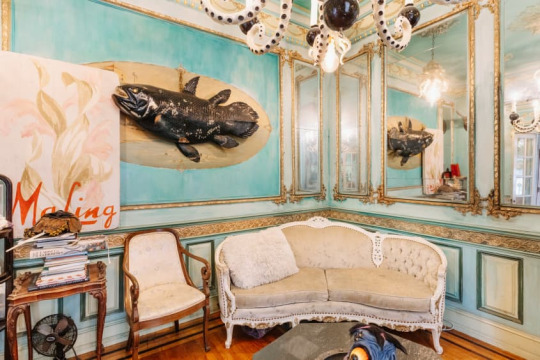
He describes his style as a mixture of the beach towns Wildwood, New Jersey and Cape May, New Jersey. Wildwood is known for kitschy ’50s neon and mid-century modern motels. Cape May is known for its gingerbread Victorians.

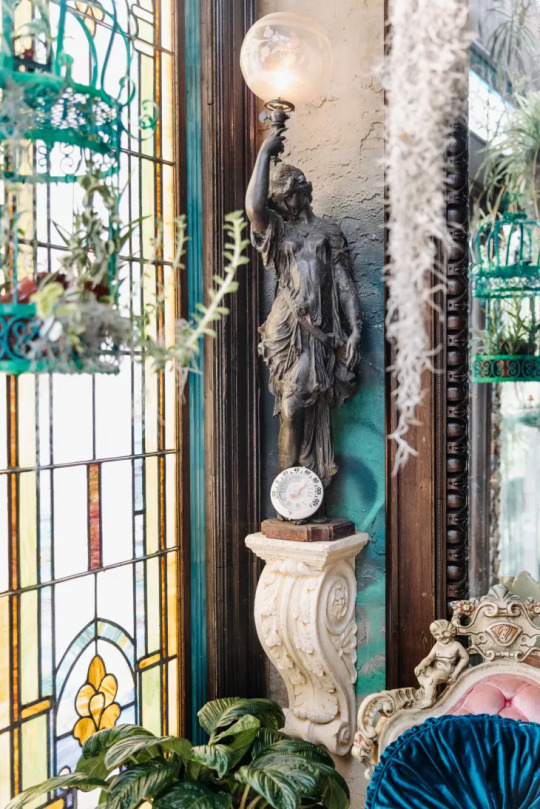
He’s proudest of the first room he did, which was inspired by Jules Verne’s “20,000 Leagues Under the Sea.” It’s the room that he made the first octopus chandelier for.
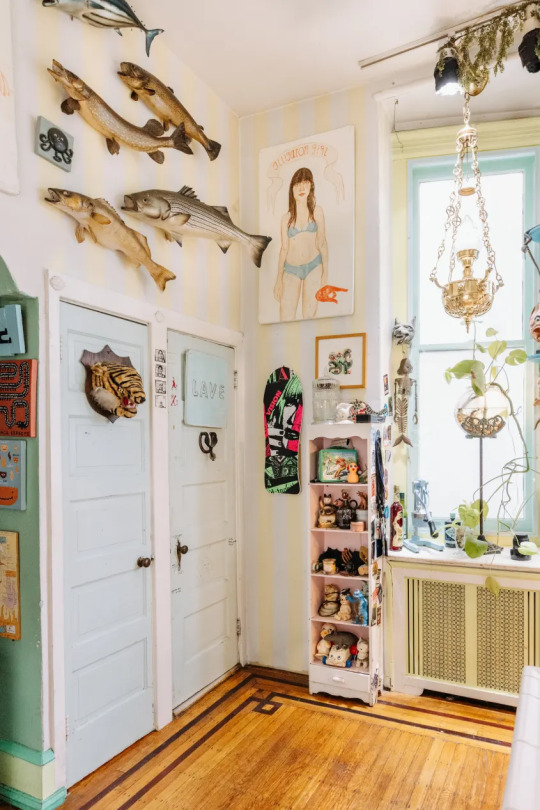


Chandeliers are how he makes his living now.

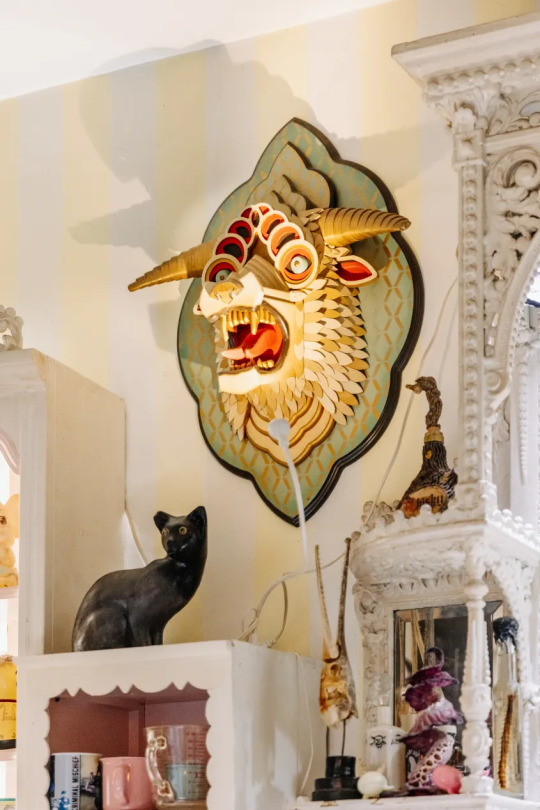
He was broke when got the place, but was able to do things like bling it out in ornamental plasterwork with help from a friend who has a plaster studio and let him borrow from her extensive rubber mold collection.

There’s a perfect long decal for fridge.

Adam says that a backpack vacuum cleaner is the best thing he ever bought to dust the house.

Adam’s advice: Don’t be afraid of messing stuff up. It can always be redone.

And don’t be afraid of what people are going to think. Do it for yourself first and not for trying to impress others.

Being pretentious works in what you do as well as what you don’t do that’s not yourself or true to your vision.

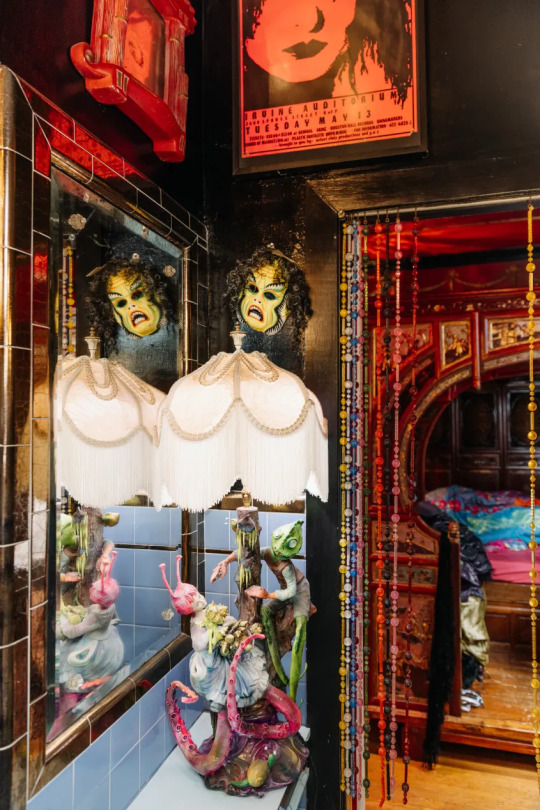

It’s okay to emulate others but always give credit to those who inspired you and try to put a spin on it.


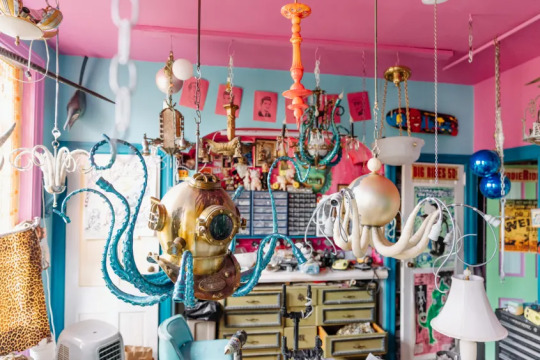
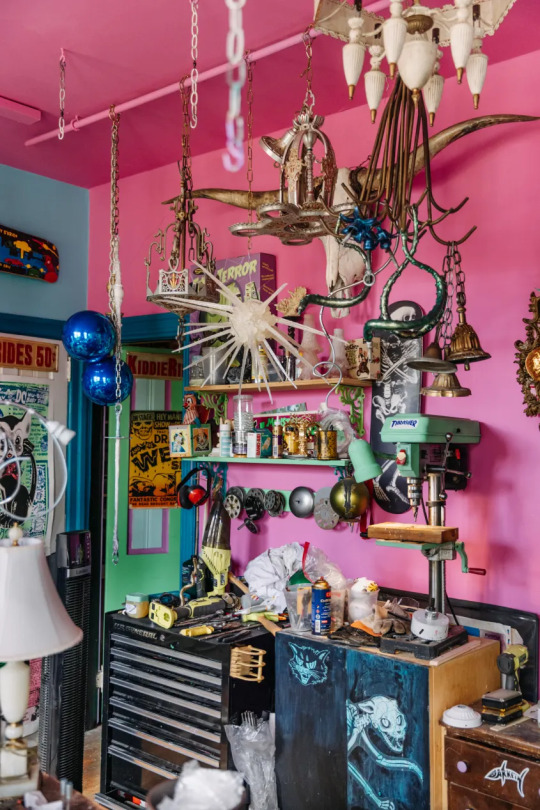
Adam says that his home is basically a show room for his chandeliers. His studio is on the third floor as well.

His biggest indulgence is the second floor greenhouse and backyard.
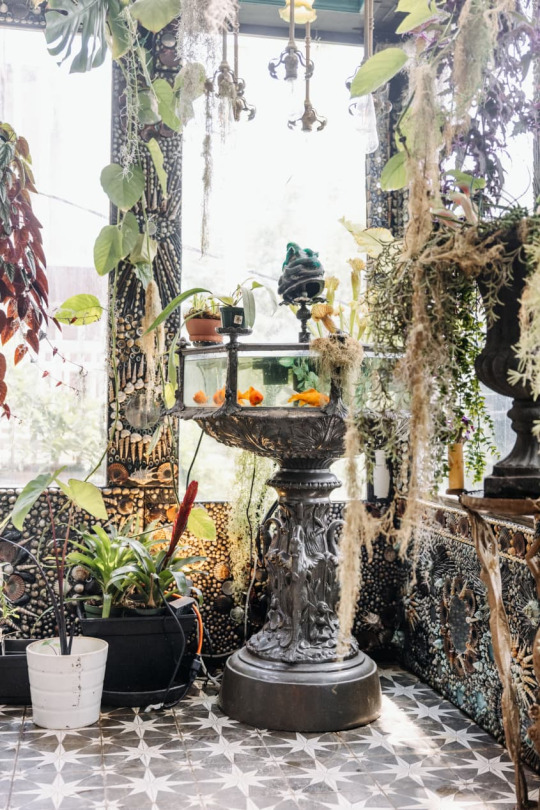
It’s not finished or really started on yet, but the room under the greenhouse is going to be the seashell grotto room.
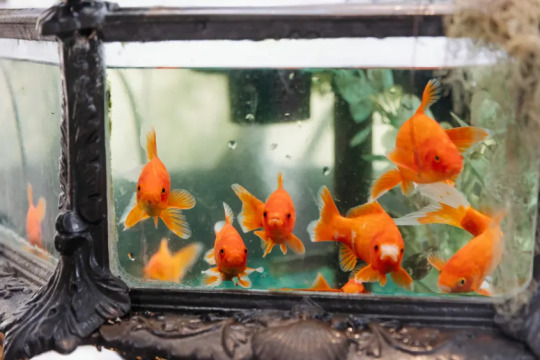
Adam’s fabulous Victorian fish tank and goldfish.
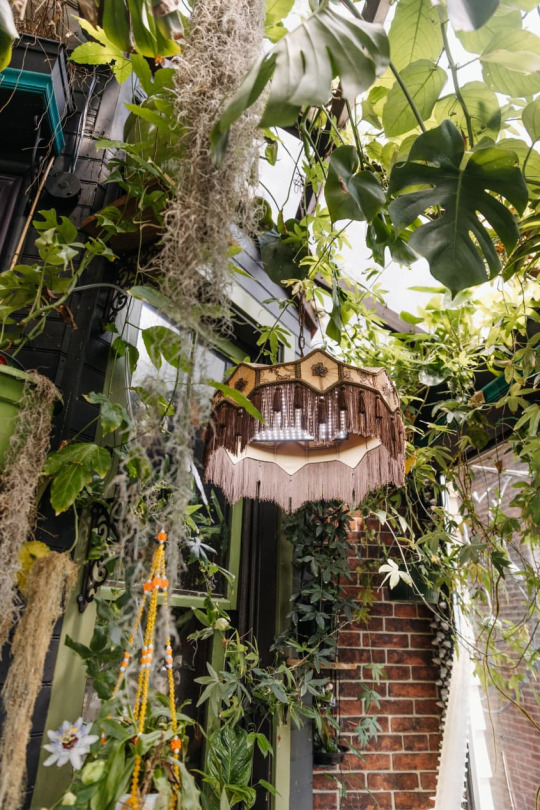
Adam’s absolute best home secret is to let your freak flag fly.

If you are remodeling, Adam says to mess with what you are getting rid of, for practice.

What a beautiful back garden.
https://www.apartmenttherapy.com/adam-wallacavages-south-philadelphia-home-37137656
601 notes
·
View notes
Text
Unfinished - Part One: Love is Like Ghosts
A/N: Happy Spooky Season, friends! This story has been marinating in my brain for the last few months, and I am super excited to share it with you. It's my first stab at something truly spooky, and though this part is mostly set up, the next few should hopefully bring the scares. If anyone is curious about the inspiration for this story, please please please feel free to ask because I have LOADS to say about it! I hope you guys enjoy my ghosties!
*Chapter title comes from Love Like Ghosts by Lord Huron*
Warnings: death, illness, murder, infidelity (not Reader and Marcus) mention of loss of parent, language
Word Count: 4,723
Summary: Maplewood Manor has a long history, not all of it pleasant, and not all of it known. You and Marcus also have a long history, and when you reunite for a few days, both of those long histories become intertwined.
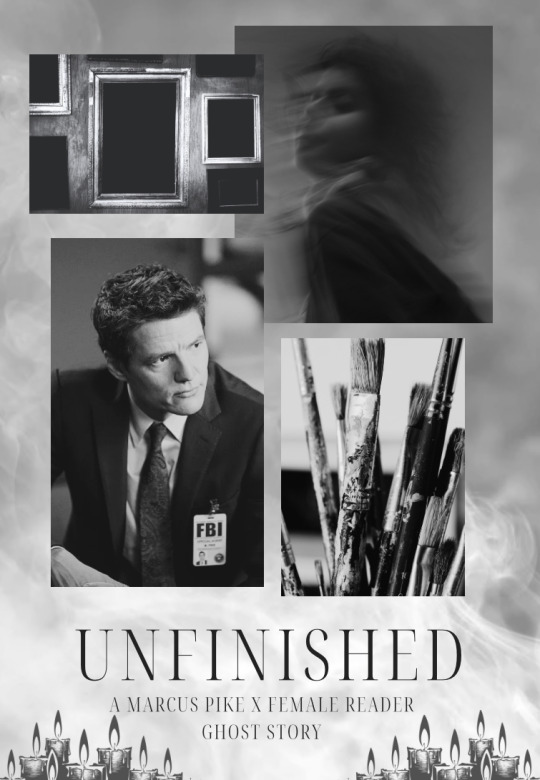
Maplewood Manor - October 30, 1868
Henry Ashford stood at the window of his wife’s sickroom with a decision to make.
His hands gripped the wood that framed the panes of glass as he watched three bright orange leaves swirl through the chilly autumn air on their way to the ground. Ever since he was a child he had been fascinated by the colorful display of the changing fall foliage, the leaves seemingly celebrating their own impending demise by turning as bright and beautiful as they could before departing from the branches they were born to. Once they’d fallen, he would traipse through the grounds in search of the right one - one with perfectly shaped edges or the most vivid golden hue. Bringing it back inside he would take it to his mother, the woman pressing it under glass to preserve it through the colorless winter. Henry would hang the glass encased leaf in his window like a suncatcher, marveling at the ghost of autumn he’d captured until Spring came again with its buds and blossoms. And then the leaf would be discarded, the glass awaiting its next specimen until he outgrew the childish hobby.
Or perhaps outgrew was the wrong word for it. The fascination with preserving the beauty of things that had died stuck with him, stoked and fed by his father’s work in the burgeoning field of photographic technology. James Ashford was the owner of the largest camera company on the East coast, and the invention of the daguerreotype took his sales to new levels, solidifying the Ashford fortune for generations to come. At the same time it solidified Henry’s interest in a new method of preservation - postmortem photography.
It was a strange thing for a young man to be interested in, and as such, Henry himself was regarded as a bit strange. Nevertheless when the time came to marry, a suitable match was made for him in the form of Eliza Cutwright, the daughter of a wealthy banker from Philadelphia. It was not a marriage of romance, nor was it one of shared interests. Though she was wed to one of the most influential men in the photography industry, Eliza preferred the majesty of oil based portraits and pencil sketches to the cold reality of anything caught by a camera lens. It was rendition, interpretation, that she found fascinating - the way an artist would paint their version of the truth, the world as it was through their eyes, with emotion and passion. Not the scientific chemical process of taking and developing photos.
The Ashfords though, like any respectable family of the time, functioned as they were meant to. They hosted and attended high society events, Eliza playing the role of the ever-devoted wife, always a smile on her face, her arm always linked with Henry’s while they laughed and hobnobbed with investors and socialites. They had two children - a son, Edwin, and a daughter, Josephine - ensuring that their family legacy would live on for future generations. On paper, Henry and Eliza Ashford were an enviable couple.
Behind closed doors though, they hardly had anything to do with one another. Each year that passed seemed to widen the gap between their mindsets, every bit of growth that Henry’s company saw driving Eliza further into her love of the traditional arts. He spent more and more time in their townhome in the city, giving the excuse that he was busy with running his father’s company and leaving Eliza on her own at Maplewood, only returning when decorum called for it. It kept both of them happier and made it easier for Henry to stomach his wife’s obsession with fighting against modernity.
In turn, Eliza felt freer in her husband’s absence to commission artwork for their home, to visit galleries and meet with artists. In the Spring of 1868, while at tea with a friend, she was reacquainted with one of the first artists she had ever met - Calvin Harper.
Cal was the son of the artist that Eliza’s parents had commissioned to create both individual and family portraits of the Cutwrights, and he would tag along with his father when he came for sessions. While the rest of Eliza’s family had their turns sitting for Cal’s father, she and the boy, roughly the same age, would play in the gardens or else in one of the house’s many rooms. The only time Cal would be at his father’s side, watching each painstaking stroke of the brush, was when Eliza was his subject. Mr. Harper would later credit Eliza for Calvin’s interest in art. Their friendship, though not one of equal social status, was allowed to continue even after Cal’s father had completed his work, but it was terminated the minute Eliza was betrothed to Henry. It wasn’t proper for a married woman to keep company with bachelors.
Especially bachelors that same married woman had always harbored affection for.
But when she saw a piece hanging in her friend Grace Felton’s parlor, the same movement and light present in every brushstroke and the familiar C.H. signature in the corner, she knew at once that it was Cal’s work. Grace had purchased some of his paintings and had taken his information so that she could hire him to do portrait work. At Eliza’s request, she put the two old friends back in touch, and though it had been nearly a decade since they’d seen each other last, nothing had changed between them. Their friendship was rekindled as though it had never been dampened, Eliza inviting Cal to Maplewood and commissioning him for the same work that her father had hired his for.
He started with portraits of Edwin and Josephine, the children taking an instant shine to their mother’s childhood friend, running to greet him when he arrived, stuffing little bouquets of wildflowers or interestingly shaped rocks into his hand as gifts. Josephine had even made him a drawing, once, the girl beaming as he heaped praise upon it. He reciprocated with sweets and the occasional small toy. By the time both of their portraits were finished, Cal had himself two little shadows that sat and watched in awe as he painted, just as he used to watch his father. The way that they interacted only made Eliza’s heart grow more fond of him, and he more so of her. She began to imagine what it would have been like had she and Cal never been separated, daydreaming a life where they’d been together the entire time, where Edwin and Josephine were his and the four of them were a family. Where she’d never met Henry Ashford and never had to pretend to be anyone other than who Cal Harper knew her to be.
The affair seemed inevitable, largely because neither party did anything at all to stop it. It began while Eliza sat for her portrait, the little willpower that either of them had to keep things plutonic vanishing entirely once Cal’s eyes studied every detail of her face, once she watched the lick of his tongue against his lips as he concentrated. They were careful not to let the maid or the butler see, and they never shared more than a brief embrace in front of the children, not wanting to drag any of them into things should Henry arrive home unannounced. But during the week or so that Cal stayed at Maplewood while he worked on a painting of the house and grounds, he and Eliza took every chance they could to slip away to the meadow at the edge of the property, or else up and away into one of the many spare rooms.
The one that ended up being the last room either of them ever set foot in, actually. The room that eventually became Eliza Ashford’s sickroom.
Just as the affair itself seemed imminent, so too was Henry catching wise to it. He met Cal on a visit back home, the artist taking the opportunity to start Henry’s individual portrait while he was available, setting Eliza’s aside to finish once he was gone again. Nothing happened then to tip him off about what happened while he was away, the two men saying very little to one another but remaining civil. Despite his affinity for photography, Henry was actually quite pleased with the outcome of Cal’s work, bestowing a handshake on him. It wasn’t until all four Ashfords were sitting as a family that Henry picked up on the attraction humming between the artist and his wife - and between the artist and his children.
It wasn’t as though he remained loyal to Eliza while he was away. Henry had at least two women in Philadelphia that Eliza knew about. But a man of his stature was almost expected to have a mistress, and so long as there were no bastards involved and no one important caught wind of the man stepping out on his wife, it was like it never happened.
What enraged Henry about Cal and Eliza’s tryst was the fact that it occurred in their home. It was the fact that Eliza had allowed Cal to become close with the children. It was the idea that Edwin or Josephine might slip and mention their mother’s good friend who spent long weekends at Maplewood while their father was gone. It was the ramifications of a leader in the camera industry’s wife spreading her legs for a common artist. It was pride, more than anything.
He knew for certain that something existed between the two when Eliza fell ill and Cal still came to Maplewood. He’d given the excuse of needing to refine the painting of the house - more detail in the cornices or better color matching to the stained glass windows - but that hadn’t kept him from making a stop to see her. The final nail in the coffin had been the sketches Cal had brought to show Eliza, hoping that they would lift her spirits - sketches of her, not a stitch of clothing to cover her body, sketches of the two of them together in positions he dreamed of during their ten years without contact. Sketches that included birthmarks that only Henry should know about on Eliza’s body. Sketches that fell out of his bag and that Henry found on the floor of the hallway outside Eliza’s room.
The doctors said it was consumption, but the medical world would likely later redefine her condition as a type of lung disease, non-infectious, which was why no one else caught what was killing her. She may even have survived her illness given a few more weeks to recover. But those sketches became her true cause of death. Cal’s, too.
Edwin and Josephine had been sent to stay with their governess at the townhome in the city while their mother was sick since no one knew that it wasn’t contagious. The staff had been pared down to just the housekeeper, who had gone into town to go shopping, so there was no one home to hear the gunshot that tore through Cal’s skull, and there was no one home to stop Henry from aiding Eliza’s death with a pillow over her face.
Which led Henry to the decision that he needed to make. The way he saw it, he had three options.
The first was to turn himself in for the murder of his wife and her lover. He would go to prison. His father’s company, his company, would be dragged through the mud, and Edwin and Josephine would likely never speak to him again, let alone have anything of his to carry on which was the whole point of their births. This was the option he gave the least amount of thought to.
Option number two was to follow Eliza and Cal by swallowing a bullet of his own. In his eyes it was preferable to prison. There was even the possibility that when the three bodies were discovered, authorities would assume it was a murder-suicide committed by Cal. The children would grow up traumatized by the story of their parents’ murders, but Henry figured that would already be the case after losing their mother so young. The company would survive, and nothing of the estate would be liquified. Henry didn’t want to die, though, so he put that one out of his mind, too.
That left the third and final option - disposing of Cal’s body before anyone returned, and passing Eliza’s murder off as a natural cause. Because he hadn’t shot her, there was no wound. It would be easy to say she’d died in her sleep. Cal had fallen in the center of an area rug, which meant that the mess was contained and would be simple enough to bundle up and drag into the cellar. The floorboards were removable, and there was plenty of space for a 5’11” corpse to never be found.
Turning from the window pane and back to the gruesome scene in front of him, he made his choice.
It wasn’t until both bodies had been dealt with that Henry noticed the easel in the corner of the room, Eliza’s half-finished portrait staring through him from an otherwise featureless face.
– – –
Maplewood Manor - October 30, 2023
You sat at the long elegant dining table going over the notes for your lecture and listening to the murmur of the crowd as people shuffled into the next room to take their seats.
Sounds like a full house out there.
As a member of the Society for the Restoration of Maplewood Manor, you were obligated to host one fundraising event that was open to the public a year, and whenever you could, you chose to do something that had a Halloween spin on it. Other members chose things like tea parties, dinner dances, or summer barbeques on the sprawling lawns. People from the area - and even some from further away - would purchase tickets, and then whoever was in charge of the event would round up sponsors to donate whatever was needed so that 100% of the profits could go back into the maintenance and repair of a two hundred year old estate.
Maplewood had been in rough shape until the fifties, the deed falling into the township’s hands when the last owner had passed and there was no one looking to move in. It was turned temporarily into an art gallery, which had done severe damage to the walls and floors, not to mention the botched job that some electrician had done with the wiring of overhead lights. Eventually the property was purchased by a local university and that’s when the serious repair work had begun and the Society formed. Years later you would end up attending the college, which was how you got involved with the restoration, and though you’d graduated almost twenty years ago, you were still an active member.
The event that you were hosting was entitled Unfinished Business: Ghosts Caught on Canvas. You’d decided to go with something that combined your interests and skills. You were an artist by trade, but your focus was very atypical. Though you did also create your own original works, you’d made your name in the art world by completing works that had been left incomplete by their creators’ deaths. Sometimes the families of the artists would commission you, other times you were contacted by museums, universities and private collectors. In a way, you felt like you were bringing closure to the people who hired you, and to the actual pieces of art themselves. Your lecture didn’t include any of the pieces that you’d worked on, all of the ones you’d chosen to highlight still unfinished and baring all of the sketchy lines and over-painted areas that showed how their artists were still unsure or undecided about how that portion of the piece would look when it was done.
To your surprise, the event sold out in under a week when normally tickets for these events would still be available at the door. You were glad that you’d been able to contribute something so beneficial to the restoration society. But an even bigger surprise came in the form of one of the attendees on your guest list - Marcus Pike.
You smiled to yourself as you recalled the message you’d sent him as soon as you saw that he had purchased a ticket. This really you? You’d sent it along with a screenshot showing his RSVP, and within seconds he had responded. Do you know any other Marcus Pikes? It had made you roll your eyes and snort, but at the same time it filled you with excitement. You hadn’t seen much of Marcus in the past few years while he was in Texas, and hadn’t spent a Halloween with him since the year after the two of you graduated college.
Which sucks, because he’s so much fun around this time. And… and I miss him.
Though you’d remained as close as you could from so many states away, nothing beat the few times you’d visited one another when he had time off from work. But none of those visits had been in the month of October. Another smile climbed your cheeks - along with a splash of heat - as you thought back to the first Halloween you spent with him, and the night that the two of you met. You and Kelly, your roommate, were hosting a costume party, and you were meeting her new boyfriend for the first time. Though their relationship wouldn’t last, you had formed a friendship with the cute guy from 2E who showed up in an impromptu sheet-ghost getup that would at times border on something more but never truly solidified into anything official. You’d kissed a few times, even slept together once, and more than a few of both of your friends had assumed that you would end up together.
But then Marcus had moved south to start his career, and the will they won’t they question seemed to be answered with a won’t. And then he met and married Erin, and even when the marriage quickly came apart, you never really considered that the two of you would shift gears.
And then there was Teresa.
You wrinkled your nose at the thought of the woman and the bullshit that you knew she put Marcus through. In a way, you were glad that they hadn’t worked out, because you didn’t think you could stomach being nice to someone who had toyed with your best friend the way that she had. But at the same time, you felt for him, because you knew that when Marcus went in on a relationship, he went all in. He fell hard, which made it hard for himself to get back up sometimes. Moving back East to D.C. was good for him in that regard, and selfishly, it was good for you, too, because him being only two hours away meant that more regular visits were back on the table.
Your phone chimed on the table next to your notes, and you couldn’t help the way your face broke into a grin as you read the text displayed on the screen. Just got here. Place looks great, can’t wait to hear your lecture! Another text bubble popped up that made you pull your bottom lip between your teeth. And to seeing you.
Before you could respond, Xander, one of the grad students who was part of the restoration society, poked his head into the room where you sat to let you know that you were all set to start.
“Thanks, X.” You smiled at him and gathered your note cards before heading into the next room.
Thanking everyone for coming - and honing in on Marcus as you said it - you launched right into your presentation.
“Real quick, before I start, how many of you all have been on a supposed haunted tour? Of a house or a city or graveyard?” You paused to let people respond, counting the raised hands in the room. About half of them were in the air. Not surprised. You smirked. “Now keep your hand up if you actually saw a ghost on any of those tours.” A ripple of laughter went through the room as every hand dropped back down. “That’s what I thought. Now, show of hands, how many of you really truly believe in ghosts?”
This time, only a few people put their hands up. Again, not surprised. But you acted surprised anyway. “Really? Almost everyone in here has paid money to go on a ghost tour, but only four of you actually believe in ghosts?”
That got another round of chuckles, Marcus’ hitting your ear over the rest. “Well, don’t worry. I’m not asking you to believe in ghosts tonight. The word belief implies that I’m expecting you to put your blind faith in something without being able to prove that it’s true. But I have proof. Solid, physical proof of ghosts that exist here in our world. So I’m not asking you to believe. I’m telling you that ghosts are real. And now I’m going to show them to you.”
You could feel the rush of anticipation in the room, everyone going from joking and laughing to scooting forward in their seats at your promises. For the next hour and a half, you went over the selected works, pointing things out and connecting each piece with its artist, sharing facts and stories about them when they were relevant or entertaining.
“You can still see the sketches underneath, right here. In this corner of the image. It’s almost as though the artist hadn’t decided yet - should the wings be unfurled or folded? The pencil lines here and here would indicate that originally they were open, spread wide. But from the beginnings of the brushstrokes over here it seems like maybe he was considering a different pose. And we’ll never know which way it was intended to be, or if the wings would even still be there in the final piece. So in a way, the painting itself is haunted, full of the ghosts of the artist’s original intentions.”
You finished up your talk by briefly explaining how you did your job - how you tried to immerse yourself in the mindset of the artist by gaining access to their journals, letters, photographs or any information about their life at the time that they were working on the piece, and then do your best to match the different styles and color palettes to complete the picture. Wrapping it up by thanking everyone again, you let people know that refreshments were available in the dining room and that you’d be available for any questions for about a half hour. Most people made their way in for snacks, but a few lingered for your informal Q & A. You gave them your undivided attention, which was difficult knowing that Marcus was hovering just beyond the small group that had formed around you and the six easels behind you.
But there was no urgency, no rush to finish up and spend time with him, because he had four days off and was planning to spend three of them catching up with you. When you were finally done and the last person had thanked you for your time, you turned to Marcus and blew out a huff. “Well that went well I think.”
He grinned wide, the expression lighting up his eyes. “You think?” Without warning, he moved in to wrap you in a hug, arms winding around you and giving a brief, tight squeeze. “You did great.”
Returning the hug, you laughed. “Thanks, Marcus.” The scent of his cologne hit your nose and you had to stop yourself from burrowing into his neck to inhale again. Instead, you pulled back to see the smile he was still wearing. “I’m so glad you could make it. Been a while since we’ve been in this building, huh?”
Marcus glanced around the room and nodded. “It has. Brings back a lot of memories.” He looked back at you and winked. “Good ones.”
It does.
Marcus hadn’t been in the restoration society with you while you were in school, but there were a number of campus activities that happened at Maplewood Manor, so you’d both been in the old mansion plenty of times before that night.
You kissed me in the parlor room junior year. Doesn’t get better than that, Marcus.
You wondered if that was the memory that came to mind for him, but before you could get too caught up in that thought, he spoke again. “Not to rush you out of here or anything, but I’m starving. You ready to go grab dinner? On the way here I noticed that Michael’s Diner is still open and I’ve been thinking about those disco fries since then.”
Your eyes widened. “Of course Michael’s is still open, that place is an institution, Marcus. And yes, I’m also very hungry. Let me just check in with Xander and the other student volunteers to see if they need anything before we head out.”
“Sounds good. I’ll be here.”
Verifying that Xander had everything he needed to close up once the remaining guests had cleared out, you thanked the kid and rejoined Marcus. “Alright, all set. Let’s go pig out like we used to.”
– – –
You’d made it halfway through your meal and most of the way through listening to Marcus tell you about his latest case when your phone rang. Reaching to silence it, you noticed Xander’s name on the I.D. “Sorry, I need to…” You trailed off pointing at your phone and showing him the screen. “Xander probably forgot his key or something.”
Marcus held up both hands, palms facing you. “Of course, go ahead. No need to apologize.”
Nodding, you answered. “Xander? Everything o-”
“You need to get back here. Now.”
The young man’s voice was thin and shaky and it made your stomach drop. Something was wrong, very wrong. It wasn’t just a forgotten key or a lock he couldn’t figure out, and the fear in his voice made your stomach drop. Your expression must have given you away because Marcus’ eyebrows pinched together in concern as he sat across from you.
“What happened, X? You okay?” Your pulse pounded in your brain as you asked.
What could have happened? I haven’t been gone that long.
“There’s… someone…” He gasped a breath and swallowed, saying your name. “I called the police already, they’re on their way and I’m across the street at the security booth, but… There’s a body - a dead body in one of the bedrooms upstairs. I… I was doing a sweep before I closed up and…”
“Oh, shit.” You breathed the two words out, ice flooding your veins as the concern on Marcus’ face went full-blown. “Oh, shit, Xander. I…”
“There’s… s-something else, too.” You heard him swallow again. “When I came back downstairs there was… You only had six paintings in your lecture, right?”
Blinking quickly, you nodded even though he couldn’t see you. “Yeah, why? Is one missing?”
“No. No, nothing’s missing. It’s… there are seven now.” He paused. “Where… how are there seven now?”
“Okay, X. Alright, sit tight until the police show up.” At the mention of the police, Marcus shifted into law enforcement mode, eyes laser focused and hands already moving to pull his wallet out and drop cash on the table. “I’ll be there in ten minutes, okay?”
How the fuck… a dead body? What the… how? When did that happen, I was up there earlier in the day and then the door to the staircase was locked and-
“Hey.” You looked up at Marcus as you both stood from the table. He shook his head. “What’s going on?”
“Xander said he… Marcus, there’s a body. At Maplewood. Someone was killed, and… and there’s another painting that I didn’t bring with me now. I… I don’t-”
“Alright.” He reached for your biceps, taking a deep breath and letting it out to try to get you to do the same. “Okay. Leave your car here. I’ll drive. Let’s go.”
You nodded and tried to calm yourself down, the task made easier by the fact that Marcus was with you, and then you let him steer you out of the diner and into his car.
-- -- --
Thank you for reading! If you’d like to be added to or removed from the tag list, please feel free to let me know. You can also fill out the form on my Masterlist! :)
tags: @something-tofightfor @littlemisspascal @mishasminion360 @nyctophiliiiiaaa @alraedesigns @practicalghost @tanzthompson @amb11@harriedandharassed @woodlandmouth @thescarletfang @trickstersp8 @princessxkenobi @imtryingmybeskar @haylzcyon@wildmoonflower @mswarriorbabe80 @theredwritingwitch @silverstarsandsuns @pedro-pedrito-pascalito @jedi-in-crocs @hannahkatharine @anoverwhelmingdin @chiyo13 @myloveistoolittle @spishsstuff @Noisynightmarepoetry
#marcus pike x female reader#marcus pike x you#marcus pike x reader#marcus pike fic#pedrostories#marcus pike the mentalist#marcus pike#spooky story#love is like ghosts#unfinished#pedro pascal character#marcus pike fanfiction
71 notes
·
View notes
Text
SET TWO - ROUND ONE - MATCH FIVE
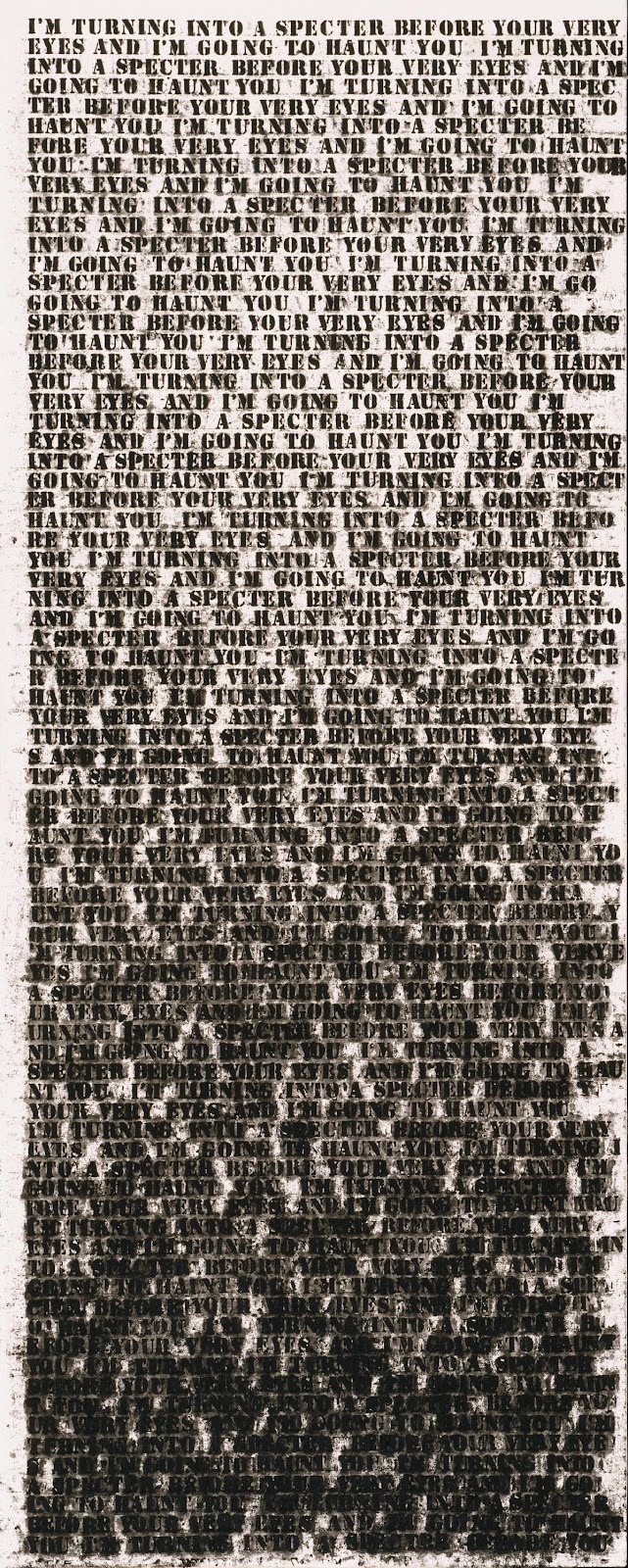

"Untitled (I’m Turning Into A Specter Before Your Very Eyes And I’m Going To Haunt You)" (1992 - Glenn Ligon) / "Two Sisters (On the Terrace)" (1881 - Pierre-Auguste Renoir)
UNTITLED: It’s very imposing sitting where it is in the Philadelphia Museum of Art. It features the same phrase over and over going down the page getting splotchier and darker going down. The phrase comes from the 1958 play The Blacks: A Clown Show, which was written to examine racial prejudice. As the words get muddier and illegible as the page progresses, the idea is to call attention to ways that Black, queer, and other underrepresented voices are heard and recieved, even possibly becoming invisible. A good portion of this explanation is paraphrased from the PMoA website so here’s the page. (weeweewhirlwind)
TWO SISTERS: this painting makes me feel so intrigued and it fucks me up mostly because the models aren’t related and like. the questions that raises are fascinating to me. why did renoir want to paint a pair of sisters who weren’t actually sisters? or maybe one or both were adopted and so they were sisters? and even if they weren’t, even if they didn’t know each other at all, are they still sisters within the painting? how do the people in the painting differ from the people they were based on? how is sisterhood defined anyway? and does that matter? did it matter to renoir? should it matter to us? maybe they weren’t related but they still get to be sisters immortalized forever in paint and that makes me emotional. head full many thoughts!!! (magnus-rhymes-with-swagness)
("Untitled (I'm Turning Into a Specter)" is an oil and gesso on canvas painting done by African-American artist Glenn Ligon in 1992. It measures 6ft 8 1/8 inches × 32 1/8 inches × 2 inches (203.5 × 81.6 × 5.1 cm) and is held by the Philadelphia Museum of Art in Philadelphia.
"Two Sisters (On the Terrace)" is an oil on canvas painting measuring 100.4 × 80.9 cm (39 1/2 × 31 7/8 in.), painted by French artist Pierre-Auguste Renoir. It is owned and displayed at the Art Institute of Chicago in Chicago.)
#art that fucks you up tournament#polls#atfyu polls#i have Emotions about one of these#cw eye contact#cw repetition#(also hello mcga fan i see you)#id in alt text
80 notes
·
View notes
Text
John 7:40-52
Nicodemus challenged his fellow pharisees.
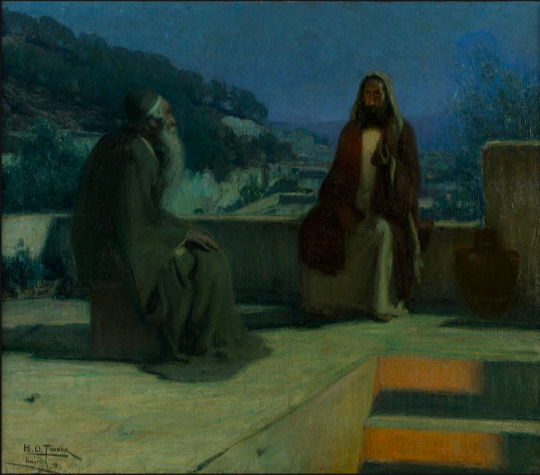
Nicodemus Visiting Jesus,
Painting by Henry Ossawa Tanner (1859-1957),
Painted in 1899,
Oil on canvas
© Pennsylvania Academy of Fine Arts
Gospel Reading
Several people who had been listening to Jesus said, ‘Surely he must be the prophet’, and some said, ‘He is the Christ’, but others said, ‘Would the Christ be from Galilee? Does not scripture say that the Christ must be descended from David and come from the town of Bethlehem?’ So the people could not agree about him. Some would have liked to arrest him, but no one actually laid hands on him.
The police went back to the chief priests and Pharisees who said to them, ‘Why haven’t you brought him?’ The police replied, ‘There has never been anybody who has spoken like him.’ ‘So’ the Pharisees answered ‘you have been led astray as well? Have any of the authorities believed in him? Any of the Pharisees? This rabble knows nothing about the Law – they are damned.’ One of them, Nicodemus – the same man who had come to Jesus earlier – said to them, ‘But surely the Law does not allow us to pass judgement on a man without giving him a hearing and discovering what he is about?’ To this they answered, ‘Are you a Galilean too? Go into the matter, and see for yourself: prophets do not come out of Galilee.’
Reflection on the painting
In today's Gospel reading, we encounter Nicodemus, marking his second of three appearances in the Gospel of John. Initially introduced as a curious seeker who approaches Jesus under the cover of night, Nicodemus is portrayed as intrigued by Jesus yet hesitant to fully embrace his teachings. His journey of faith is subtly woven through John's narrative, culminating in his participation alongside Joseph of Arimathea in ensuring Jesus receives a respectful (indeed, lavish) burial. This progression illustrates Nicodemus's gradual movement towards a deeper understanding and commitment to Jesus. Our reading today is the second (and middle) appearance of Nicodemus. Despite being a Pharisee, he displays remarkable bravery by questioning the outright dismissal of Jesus by his peers, who criticize Jesus based on his origin in Galilee, a region they regard as insignificant compared to the religious hub of Jerusalem. Nicodemus advocates for fairness and due process, arguing that Jesus should not be judged without first being heard. This stance places him at odds with the prevailing opinions of his colleagues, and his challenge is met with scorn, evidenced by their sarcastic comment "Are you from Galilee too?"
Nicodemus's growing relationship with Jesus left him increasingly isolated in the world where he had been so much at home. He actually reminds us that as we grow in our relationship with Jesus, there is often a price to be paid. We may find ourselves a lone voice among our peers. At such times, we know that the Lord is always with us.
Henry Ossawa Tanner painted our canvas in 1899, depicting the first of the three mentions of Nicodemus in John's Gospel (John 3:1-21). The painting was Tanner's entry to the 1899 Paris Salon. We see Nicodemus talking privately to Christ in the evening, a good example of Tanner's nocturnal light paintings. The painting was purchased there for the Wilstadt Collection, Philadelphia, and is now in the Pennsylvania Academy of Fine Arts. The narrative of Nicodemus' meeting with Jesus held significant meaning for Henry Ossawa Tanner's father, Benjamin Tucker Tanner. He was a Bishop in the African Methodist Episcopal Church and had aspirations for his son to join him in the ministry. While Henry's decision to pursue a career as an artist fell short of his father's dream, his talent for painting ultimately produced works that his father could admire and support.
Article by Father Patrick van der Vorst
#christian blog#jesus#bible reading#christian doctrine#bible scripture#biblical#glorytogod#bible#faith in jesus#bible study#modern art#artwork#art history#old art#religious art#bible reflection#art#artists#history#share the gospel#gospel#word of god#kingdom of heaven#christian faith#follow jesus#bible verse#biblical art#spiritual disciplines#spiritual warfare#walk with god
20 notes
·
View notes
Text

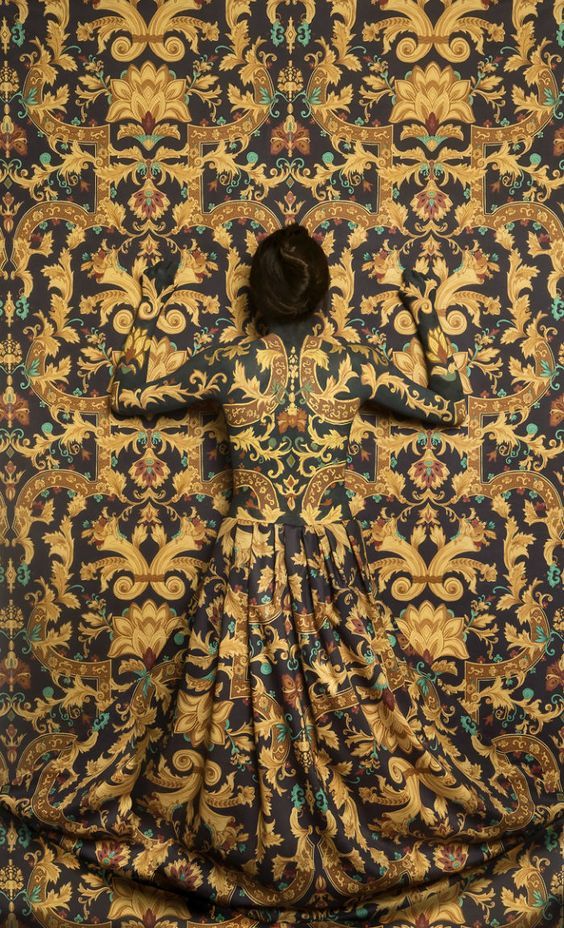

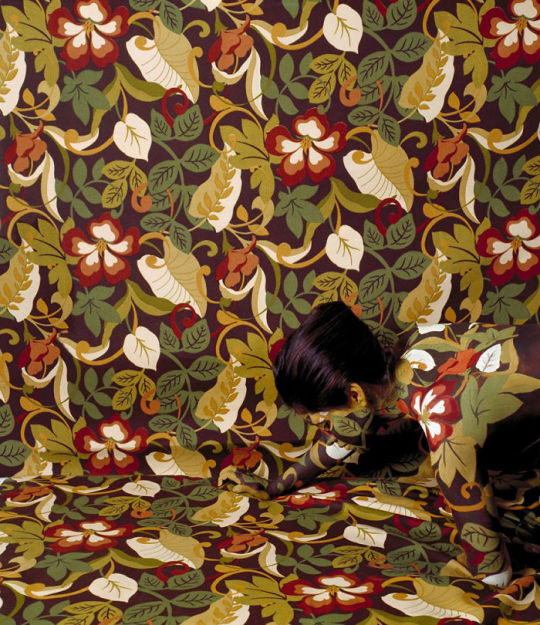

Camouflage artwork by Peruvian artist Cecilia Paredes.
Cecilia Paredes is a Peruvian-born, Philadelphia-based artist who mixes photography, painting and performance arts in order to develope a unique art form. She is the main subject of her own richly patterned artworks, yet her figure aesthetically disappears.
Instead of using canvas, Paredes paints directly onto her own skin. She uses paint and clothing patterns and blends herself into floral backgrounds like a chameleon. Sometimes she leaves her hair exposed, making her presence visible for the spectator.
“I wrap, cover, or paint my body with the same pattern of the material and re-present myself as part of that landscape,” she says. “Through this act, I am working on the theme of building my own identification with the entourage or part of the world where I live or where I feel I can call home. My bio has been described as nomadic so maybe this is also a need of addressing the process of constant relocation.”
69 notes
·
View notes
Text
The dead malls of York
Continuing on the theme from my last post about York Galleria, I'm going to talk more about the four now-closed malls in York that came before the Galleria.
The York Mall

The York Mall opened in 1968, developed by the famous Kravco Company of Philadelphia. It was a fairly large mall for its era (about 700,000 Square feet of retail space, I believe). It was primarily a single-level mall, though in this rare interior photo you can see stairs leading up to a small 2nd level that included a community room and some offices. The opening anchors were JCPenney, Montgomery Ward, and Maryland-based Hochschild-Kohn (seen in the above picture). The mall also featured a Trans-Lux Theater and a flagship location of McCrory's variety store. In fact, the McCrory's distribution center was located directly next door to the York Mall, and a concrete ramp led straight from the distribution center's parking lot right up to the back of McCrory's store around the rear side of the mall. The ramp still exists today as a relic of this bit of McCrory's history. The layout of the mall had Penney's at one end and Wards at the other, with Hochschild-Kohn right in the middle. You'd have to walk through the Kohn's department store to get from one end of the mall to the other.

Hochschild-Kohn's declined in the 70s, closing their York Mall store in 1975. York's own local department store, The Bon-Ton, opened in this spot that same year. The York Mall remained the largest mall in town for 21 years until George Zamias built the 2-story York Galleria practically next door in 1989. Both The Bon-Ton and JCPenney left the York Mall for the York Galleria when it opened, but it wasn't a total loss because The Bon-Ton kept their store open as a new discount concept called "Bon-Ton Express" on the ground floor and put their corporate offices on what had been the 2nd floor of the department store. Still, the new competition from the Galleria badly hurt the York Mall and forced it to go more downscale. Looking to replace JCPenney, the York Mall signed a lease with Arkansas-based discount store Walmart in 1990 - it was the first Walmart in the state of Pennsylvania and was then the largest in the country at 130,000 square feet. Walmart also built a new Sam's Club right next to Montgomery Ward. At the time, the destructive tendencies of Walmart were not as widely-known.

The York Mall still did alright for a few more years with its new configuration. But stores in the mall noticed a drop in business after The Bon-Ton Express closed in May of 1992. Bon-Ton executives attributed the closure to Walmart, whose cash registers only faced their parking lot entrance (in other words, you could enter Walmart from the mall, but you have to leave out towards your car). Burlington replaced Bon-Ton Express in 1993, but it didn't do much to help sales at the small shops. Around the turn of the century, the demise of Montgomery Ward and McCrory's left gaping vacancies in the north end of the mall while an expansion of Walmart into a 240,000 square foot supercenter swallowed up the entire south end of the mall. It didn't take long after that for the remainder of the mall to be demolished.
North Mall

The North Mall - "the first completely carpeted, enclosed shopping center in the East!" - opened in 1969, as the 2nd enclosed shopping mall in York, PA. It was a smaller mall that was sort of split level; the upper level was fully enclosed and anchored by The Bon-Ton and a G.C. Murphy's variety store. At the end opposite of Bon-Ton, an artistic ramp took you down to a lower level that turned into an open air strip mall. This section was anchored by a J.M. Fields discount store, which included a Pantry Pride discount grocery store inside. The whole mall was owned by Food Fair Properties, which shared the same parent company (Food Fair) as Pantry Pride and J.M. Fields.

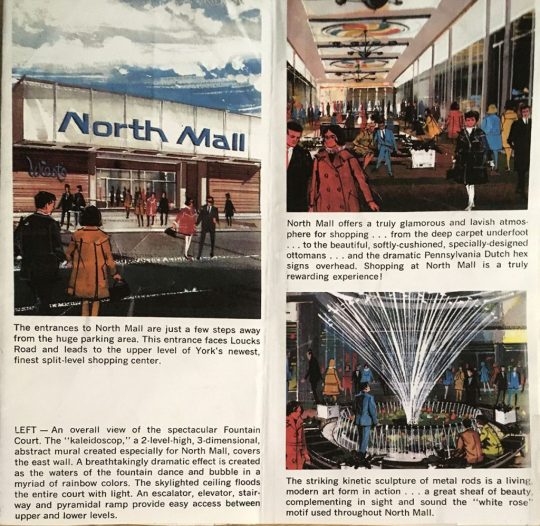
Food Fair became a pretty large company in the 60s and early 70s, having expanded its subsidiaries Pantry Pride and J.M. Fields nationally. But the business then began to suffer, leading to bankruptcy and the closure of all J.M. Fields stores in 1978. The Pantry Pride at North Mall closed as well. The anchor building that had housed Fields and Pantry Pride was large and difficult to find a replacement tenant for. It housed women's apparel store Marianne's for a few years in the late 70s/early 80s.

1981 brought the opening of West Manchester Mall, a project of famous developer Crown American Corporation. Compared to the nearby North Mall, West Manchester was much newer and larger. The North Mall had never updated, and was still very much a fully-carpeted, flower-patterned product of 1969. The Bon-Ton closed at North Mall to open a new store at West Manchester when it opened. The Bon-Ton was quickly replaced by the 4th location of discount department store Mailman's. Ironically, Mailman's had a collaboration with The Bon-Ton wherein Bon-Ton would supply their own apparel merchandise at Mailman's stores, so Bon-Ton never totally left the North Mall after all. At that point, the North Mall felt pressured to go downscale, so the mall became known as the "North Mall Factory Outlet Center". Burlington opened in the former J.M. Fields location in 1983, and the mall kept afloat for a while. In 1984, G.C. Murphy's closed their store, apparently in violation of a 20 year lease they had signed which did not expire until 1989 (this prompted a lawsuit from the mall). In 1988, the collaboration between Mailman's and Bon-Ton ended, so the North Mall Mailman's lost its whole apparel department. By the end of that same year, Mailman's closed after failing to reach a lease deal with North Mall management. This was the last staw for North Mall, which by 1990 was slated for redevelopment into "Manchester Crossroads," a strip mall. It was the first mall in York to be de-malled.
Delco Plaza Mall
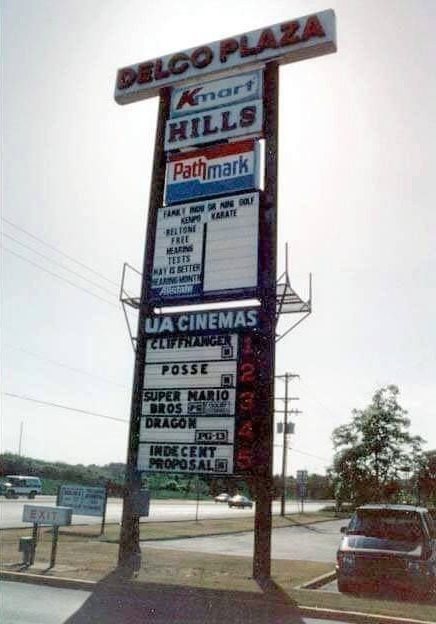
The Delco Plaza Mall was a small, discount-oriented mall opened in 1974 in west York, not far from the North Mall. It featured Hills and Grant City (both discount department stores) as anchors as well as a United Artists movie theater in the mall and a Pathmark grocery store in the parking lot. The UA theater was the first 3-screen cinema in York and drove a lot of traffic into the mall. The name of this mall has always confused me because "Delco" is common shorthand for Delaware County, PA, a county which York is very much not located in. The first issue for Delco Plaza was the bankruptcy of W.T. Grant Co., the parent company of Grant City. This resulted in what was then the largest retail bankruptcy liquidation in American history when all of the Grant's stores closed in 1976. Many former Grant Cities, including the one at Delco Plaza, were snatched up by Kmart for new stores.
In 1981, the West Manchester Mall opened, hurting smaller, older malls like Delco Plaza. At some indeterminate time after this, the UA cinema in the mall was downgraded to a cheaper, second-run theater, which had an adverse effect on mall traffic. The Pathmark also closed, and slowly the stores inside the mall began to go under as well. Though the addition of some new tenants like a post office branch and liquor store helped keep the mall open, it was not enough to save it. Hills, struggling in face of competition from Walmart in particular, was bought out by Ames discount department stores in 1999. Ames, in turn, went out of business in 2002. Kmart closed shortly thereafter. The mostly vacant mall faced demolition in 2005.
West Manchester Mall

The West Manchester Mall was developed by Crown American, one of the nation's largest privately-owned real estate developers, in 1981. It was located in west York, nearby the much smaller North Mall and Delco Plaza Mall. It was a modern, single-level mall, about the same size as the York Mall on the other side of town. It featured The Bon-Ton, Hess's department store of Allentown (which at the time was a subsidiary of Crown American itself), and Gee Bee discount store of Johnstown as its anchors. West Manchester had little drama in its early years as it enjoyed dominance in west York while being far enough from the York Mall on the east side of town to maintain a delicate balance. That balance was only really upset in 1989 by the opening of George Zamias' York Galleria. The Galleria was much larger than any other mall in York, and drew a lot of business away from the York Mall in particular.

In 1992, Gee Bee, which had just survived a bankruptcy filing, was bought by rival discount store Value City. Then, in 1993, Hess's department store was circling the drain after recklessly opening too many locations too far from its home base. It closed at West Manchester, and Crown American signed a lease with Walmart to fill the space. Crown also expanded the mall in 1995, adding a new wing leading to a new Hecht's department store of Maryland. A few years later, they renovated the mall again and added a 13 screen Regal Cinemas to occipy vacant store space and keep the West Manchester Mall competitive. But the decision to bring in Walmart turned out to be a long-term curse for the mall itself, as Walmart chose to expand into a supercenter in the early 2000s. Just as it did at the York Mall, the West Manchester Walmart took over what used to be a whole wing of the mall when it expanded. Hecht's became Macy's in 2005, and Value City went out of business in 2008, to be replaced by Kohl's. A big nail in the coffin came when in 2011 The Bon-Ton announced that their store at West Manchester was "not performing as well as it should" and would close at the end of their lease the following January. At this point, Regal was mostly the only thing keeping people coming into the mall. The mall was sold in 2012 to new owners who pledged a nearly $50 million renovation to transform it into the West Manchester Town Center, an open-air retail center. With this closure, the York Galleria became the only surviving mall out of five in York, PA.
#photography#dead mall#retail#dead malls#deadmall#mall#malls#shopping mall#shopping malls#retail apocalypse#york mall#west manchester mall#delco plaza mall#north mall#dead mall series#history#pennsylvania
75 notes
·
View notes
Text
THIS DAY IN GAY HISTORY
based on: The White Crane Institute's 'Gay Wisdom', Gay Birthdays, Gay For Today, Famous GLBT, glbt-Gay Encylopedia, Today in Gay History, Wikipedia, and more … February 10



Bill Tilden with a protégé
1893 – The American tennis player legend Bill Tilden was born on this date (d.1953). Born William Tatem Tilden II (often called "Big Bill"), he was an American tennis player who was the World No. 1 player for 7 years, the last time when he was 38 years old. Born in Philadelphia, Pennsylvania, to a wealthy family, he was a "Junior" at birth but changed his name to "II" when he was in his mid-20s.
Tilden was born into a wealthy Philadelphia family. He lost his semi-invalid mother when he was 15 and was sent a few houses away to live with a maiden aunt. The subsequent loss at 19 of his father and older brother marked him deeply. After several months of deep depression, and with encouragement from his aunt, tennis became his primary means of recovery.
According to his biographer Frank Deford, because of his early family losses Tilden spent all of his adult life attempting to create a father-son relationship with a long succession of ballboys and youthful tennis protégés, of whom Vinnie Richards was the most noted. In spite of his world-wide travels, Tilden lived at his aunt's house until 1941 when he was 48 years old. He had no sexual relationships with women at all and apparently very few sexual encounters with members of his own sex until he was well into his 40s and becoming increasingly effeminate in his mannerisms, particularly in the more liberal atmosphere of 1930s Europe.
Although Tilden almost never drank, he smoked heavily and disdained what today would be considered a healthy life style for an athlete; for most of his life his diet consisted of 3 enormous meals a day of steak and potatoes, with, perhaps, the occasional lamb chop.
Tilden was a champion player, one of the most influential persons in the history of tennis. He was also perhaps the most paradoxical figure in the history of any sport: a Gay man who almost single-handedly changed the image of tennis from that of a "sissy" country-club sport played only by rich white people in long white pants or ankle-length skirts to that of a major sport played by robust, world-class athletes. In the United States' sports-mad decade of the Roaring 20's Tilden was one of the five dominant figures of the "Golden Virgins of Sport", along with Babe Ruth, Howie Morenz, Red Grange, Bobby Jones, and Jack Dempsey. His subsequent arrests and convictions on charges of solicitation cast a shadow over his illustrious career.
Although Tilden had been born to wealth, and earned large sums of money, he spent it lavishly, keeping a suite at the Algonquin Hotel. Much of his income went towards financing Broadway shows that he wrote, produced, and starred in. The last part of his life was spent quietly and away from his family, occasionally participating in celebrity tennis matches. He died in Los Angeles, California. He was preparing to leave for the United States Professional Championship tournament in Cleveland, Ohio, when he fell dead of a stroke. Tilden was inducted into the International Tennis Hall of Fame in Newport, Rhode Island, in 1959.

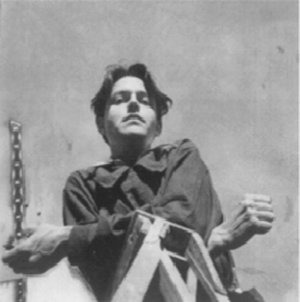
1913 – On this date Charles Henri Ford was born (d.2002). Ford was an American novelist, poet, filmmaker, photographer, and collage artist best known for his brilliant editorship of the Surrealist magazine View in New York City in the 1940s, and as the partner of the artist Pavel Tchelitchew.
Born in Brookhaven, Mississippi, he dropped out of high school and by age 16 he had started his first magazine, Blues (subtitled "A Bisexual Bimonthly"). Not long after, he became part of Gertrude Stein's salon in Paris, where he met Natalie Barney, Man Ray, Kay Boyle, Janet Flanner, Peggy Guggenheim, Djuna Barnes and others of the American expatriate community in Montparnasse and Saint-Germain-des-Près. He went to Morocco in 1932 at the suggestion of Paul Bowles, and there he typed Djuna Barnes' just-completed novel, Nightwood (1936), for her.
With Parker Tyler, who would later become a highly respected film critic, he co-authored The Young and Evil (1933), an energetically experimental novel. The novel portrays a collection of young genderqueer artists as they write poems, have sex, move in and out of cheap rented rooms, and duck into the neighborhood's many speakeasies. The characters' gender and sexual identities are presented candidly; it was this candor which was reportedly the reason for its rejection by several American and British publishers. It was finally picked up by Obelisk Press in Paris.
Ford returned to New York City in 1934 and brought Pavel Tchelitchew (Ford's life partner until the latter's death in 1957) with him. Ford's circle at the time included Carl Van Vechten, Glenway Wescott, George Platt Lynes, Lincoln Kirstein, Orson Welles, George Balanchine, and E. E. Cummings.
In 1957, Tchelitchew died in Rome. Charles Henri Ford died, aged 89, in 2002.

1950 – A Pennsylvania court convicts a man of sodomy as an accessory before the fact for driving two teenagers to a friends house and watching them have sex.

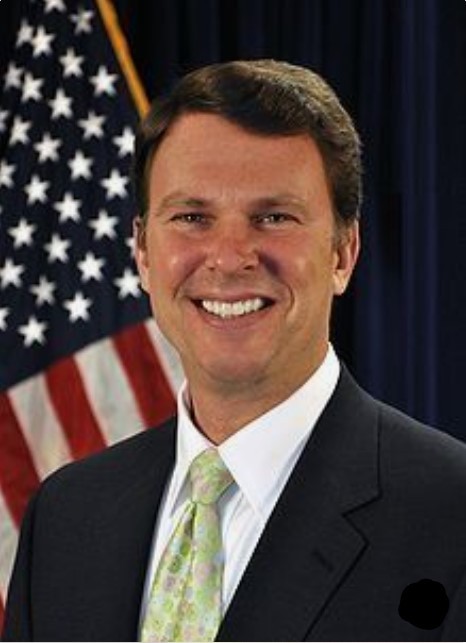
1959 – John Berry iwas the United States Ambassador to Australia from 2013 to 2016. He previously was director of the United States Office of Personnel Management.
Berry was born in Montgomery County, Maryland. He completed degrees at the University of Maryland, College Park and Syracuse University and worked in local government and as a legislative aide in state government from 1982 to 1985. From 1985 to 1994, he worked as legislative director for U.S. Representative Steny Hoyer. He held posts in the U.S. Treasury Department, the Smithsonian Institution, and the U.S. Department of the Interior until 2000, and worked as director of the National Fish and Wildlife Foundation and the National Zoological Park until 2009, when he was nominated by President Barack Obama as director of the United States Office of Personnel Management. Berry took office after being confirmed by the United States Senate in April 2009.
In June 2013, President Obama nominated Berry to replace Jeff Bleich as US ambassador to Australia, the first openly gay U.S. ambassador to a G-20 nation. He was confirmed by unanimous consent of the US Senate in August 2013.
Australian media coverage of Berry's appointment was overwhelmingly positive with a video he posted to the US Embassy website being described as the "friendliest introduction video in diplomatic history" while Berry himself was described as "modest", with an "impressive record". Federal News Radio, in the US, reported that, "more than 200 people had posted responses" to the video, "most of which were warm and cordial".
On August 10, 2013, he married Curtis Yee, his partner for 17 years in Washington.


1974 – Ivri Lider is an Israeli pop star and part of the duo TYP, also known as The Young Professionals. He served as a judge on the first season of The X Factor Israel.
In October 2005 Lider received the "Male Singer of the Year" award from all the major national and local radio stations. He composed most of the soundtrack for the movie The Bubble, and sings the song "Loving That Man of Mine".
In 2008 Lider launched a new Hebrew album and announced an upcoming English album. The music video for his English-language song "Jesse" has received a lot of airtime on LOGO TV, and Out magazine recognized him as a member of the "Out 100" for 2007.
Lider is openly gay. In January 2002, Lider spoke openly about his sexual orientation in a cover-story interview to the daily newspaper Ma'ariv, which attracted a lot of attention. He later said, "On a personal level, I felt complete and happy with my life and who I am, and I didn't see any reason to not talk about it … Maybe I can influence people and help younger people that struggle – help them to be able to change their views, and stuff like that." Lider refused to be drawn into the debate about the Jerusalem Gay Pride Parade. He did, however, accept a booking to play at the Sydney Gay and Lesbian Mardi Gras' "Fair Day" in Camperdown, Australia on Sunday, 21 February 2010.
Lider is known for the soundracks of the movies
Yossi & Jagger (2002) – original score and theme song "Bo" (Let's)
Walk on Water (2004) – original score and theme song "Cinderella Rockafella" duet with Rita
The Bubble (2006) – original score, theme song "The Man I Love", "Birthday Cake", and ending credits song "Song to a Siren"


1976 – Andy Lipincott, a character in the comic Doonesbury becomes the first character in a major U.S. strip to come out


1984 – Brent Everett, born Dustin Germaine, in Moose Jaw, Saskatchewan, is a Canadian gay pornographic actor and director. Since 2003, he has appeared in over 40 pornographic films for a variety of studios in the United States.
In his early work Brent was classified by studios as a twink; however, more recently he has become too muscular to comfortably fit in this term.
Everett has performed bareback (unprotected sex) in films for various studios (including his debut in Barebacking Across America for Tipo Sesso when he was 18 years old), but most of these were with his boyfriend at that time, Chase McKenzie, with whom he started his career in porn. (He also has participated in unprotected anal intercourse with other performers on occasion.) McKenzie had appeared in many films that prominently feature Everett as a cover model. In most appearances, Everett is a top in his videos but occasionally bottoms.
To further extend his career in porn, Everett opened his own subscription website in late 2004, offering video streams, image downloads, live web cam shows, and an online shop where he sells his used underwear. Live web cam shows are available for playback at a later date. In addition, he set up his own distribution company under the name of Triple X Studios for which he stars in and directs movies.
In September 2008, Everett made public his plans to marry fellow gay porn star Steve Pena in a ceremony to take place in San Diego, California, in October. The two were wed in a private ceremony on October 3, 2008.
In November 2017, Steve Pena announced via his Instagram that he and Brent would be separating. The two were known to be in an open relationship throughout their marriage.


1990 – Trevante Rhodes is an American actor. He won several accolades and achieved recognition in 2016 for his performance as Chiron in the Academy Award-winning film Moonlight. In his youth, he was an accomplished track and field sprinter, winning a gold medal at the Pan American Junior Athletics Championships in 2009.
Rhodes was born in Ponchatoula, Louisiana. His family moved to Little Elm, Texas when he was ten. At Little Elm High School, Rhodes played running back in an option offense with Cole Beasley at quarterback. Over his high school career, Rhodes earned four letters in both football and track and field, where he competed as a sprinter specializing in the 100 and 200 meter dash. As a junior, Rhodes finished second behind Whitney Prevost over both distances at the 2007 UIL Track and Field Championships at Mike A. Myers Stadium. While his senior year was cut short by an ACL injury on the football field, he still earned an athletic scholarship in track and field to the University of Texas at Austin. He studied kinesiology.
Rhodes competed for the Texas Longhorns as a sprinter from 2008 to 2012. At the 2009 Pan American Junior Athletics Championships in Port of Spain, Trinidad and Tobago, Rhodes helped the U.S. squad to a gold medal in the 4×100 metres relay.
Rhodes rose to fame for his much praised performance in the 2016 film Moonlight, directed by Barry Jenkins, where he played the lead role of the adult Chiron. While talking about the movie in an interview with Out, Rhodes said: "Being a black person in America right now is shit, being a homosexual in America right now is shit, and being a black homosexual is the bottom for certain people. That's why I'm so excited for people to see Moonlight. I don't feel like there's a solution for our problems, but this movie might change people. That's why you do it — because you feel like you're doing something that matters. This is someone's story." The film has won the Golden Globe Award for Best Picture – Drama and the Academy Awards for Best Picture and Best Adapted Screenplay.

2009 – On this date the American Civil Liberties Union of Florida filed a suit in federal court on behalf of Yulee High School students Hannah Page , a freshman, and Jacob Brock, a junior. The lawsuit claims violations of the First Amendment and the Federal Equal Access Act. The act requires schools to grant access and recognition to a Gay-Straight Alliance and other groups if the school allows any extracurricular group to meet on campus, said ACLU attorney Robert F. Rosenwald. The lawsuit seeks a preliminary injunction to allow the club to meet at Yulee High while the case makes it way to trial.
Page said the group just wants to meet like others do. "We just want the club so that straight and Gay kids can get together to talk about harassment and discrimination against Gay kids in an open environment. The school is discriminating against us and that's exactly the kind of thing we want to prevent," she said.


15 notes
·
View notes
Text
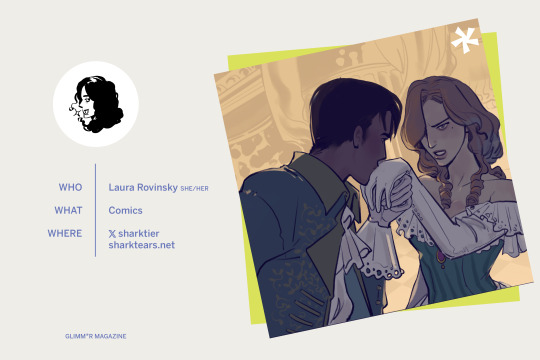

Here's a Glimm*r duo👩❤️💋👩 Laura R and Ez Carol are a comic artist/writer duo that work on queer fiction comics. Ez is a writer based in Philadelphia who favors horror, fantasy, and slice-of-life stories. Laura, a D.C.-based artist, who adores yuri, fantasy, and difficult women.
You can find Laura on Twitter at @/sharktier and tumblr on @basedtaka!
You can find Ezra at @/_ezcarol on Instagram!
8 notes
·
View notes
Text

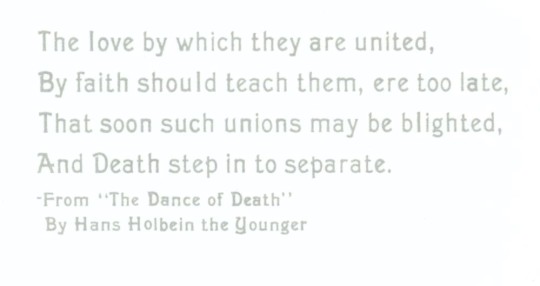

A Valentine's Day Wood Engraving Wednesday
REBECCA GILBERT
We mark this especially romantic Wood Engraving Wednesday with this wood engraving by Philadelphia-based artist and printmaker Rebecca Gilbert from the 2020 calendar of the Wood Engravers’ Network (WEN). Here, Gilbert reinterprets Hans Holbein's (1497–1543) woodcut "The Lady" from his well-known series The Dance of Death (Basel, 1523–26), with an English translation of the French quatrain by Gilles Corrozet (1510–1568) paired with the image in the 1538 Lyon edition, reminding us that love is only temporal, so we should rejoice while we have it. Of her work in wood, Gilbert's website notes:
These processes allow the integration of a high level of detail and the ability to work both very large (woodcut) and very small (wood engraving) simultaneously. The contrast in scale directly relates to the ways she explores ideas of perception, space, and seeing.
Our copy of the calendar is a donation of WEN member and Wisconsin resident Tony Drehfal.

View posts from Valentine’s Days past.
View more posts from the 2020 WEN Calendar.
View more work by women wood engravers.
View more posts with wood engravings!
#Wood Engraving Wednesday#St. Valentine's Day#Valentine's Day#love#death#wood engravers#women wood engravers#Rebecca Gilbert#The Dance of Death#Hans Holbein#Gilles Corrozet#Wood Engravers' Network#WEN#WEN Calendar#Tony Drehfal
9 notes
·
View notes
Text
Devan Shimoyama.


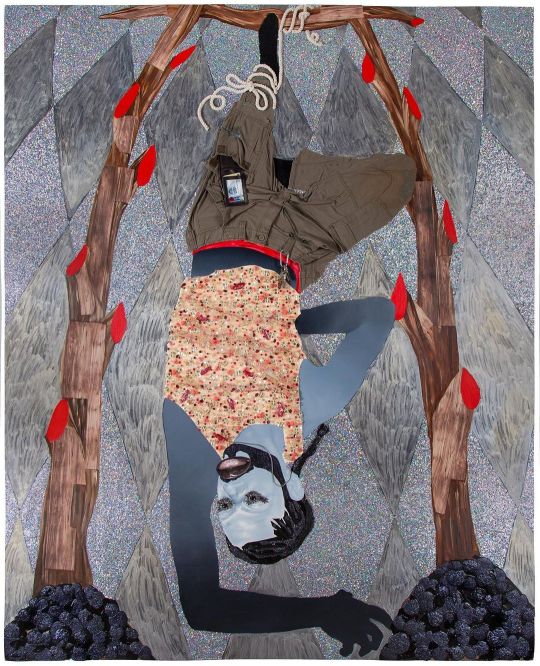
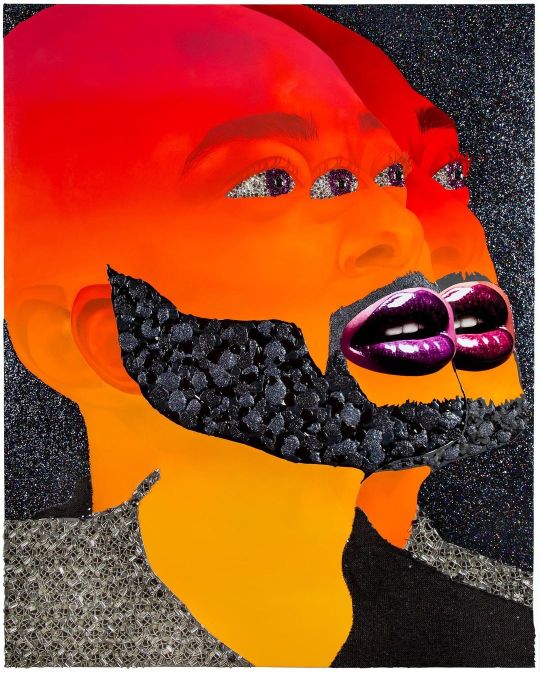



Philadelphia-based artist Devan Shimoyama creates dreamlike and shimmering canvases featuring Black, queer figures in moments of both vulnerability and empowerment. He combines formal portraiture, inspired by Old Masters such as Caravaggio and Goya, with an imaginative use of materials that includes jewelry, sequins, flashe, fabric, and traditional paint and colored pencil. His artworks offer a captivating and enchanting view of Blackness, queerness, and masculinity. Shimoyama received his MFA from Yale and has exhibited his work in major cities across the globe, including Los Angeles, New York, London, and Paris. His first solo institutional exhibition was presented at the Andy Warhol Museum in 2018.
Shimoyama's canvases offer a vibrant and ostentatious representation of race, gender, sexuality, and class. With their spectacular surfaces, his paintings hold the viewer's gaze with their mesmerizing beauty. By fusing different materials and styles, Shimoyama explores themes of identity and culture. His unconventional yet intriguing approach to portraiture has earned him recognition as a prominent figure in contemporary art. Shimoyama's artworks are an exploration of the relationship between form and content, inviting viewers to reflect on the complexities of everyday life.

THE SUPERSONIC ART SHOP | FOLLOW ON INSTAGRAM
67 notes
·
View notes
Note
Fic asks!
#13 and #23
hi!
13. favorite writing song/artist/album
it will definitely be ethel cain. Always an Angel fully belongs to Preacher's Daughter/Inbred. The idea come from Western Nights/Thoroughfare, the entirety of Remus' character came from listening to Family Tree (Intro) on repeat, Sirius is Gibson Girl/Unpunishable. All credit to her she wrote the fuck out of those songs.
special shout out to Let's Get Loud by J-Lo for that one chapter of Twin Machines and Noah Kahan for the long fic I almost wrote. RIP
23. fics you wanted to write but didn't
In memoriam moment for the following:
MCD band fic
Maine/Noah Kahan long fic spanning 10 years following 7 of them
a philadelphia story au
the stripper au
a 50s stock car racer fic (the first idea i ever had for a fic)
an entire series based on Painting of a Panic Attack by Frightened Rabbit set after the war
A twilight zone Monsters on Maple Street inspired wartime fic
a surreal fic that was very Rocky Horror/I'm Thinking of Ending Things inspired by the music video for Karmacoma by massive Attack
evil James murdering for Regulus during the war
a lily/mary high school romance fic based around mary's unreal classic car and a house party
"his daddy's on death row" a prison wife remus extravaganza
a brothers fic for regulus and sirius based on organized vs. disorganized chaos
a time turner jegulus fic where regulus is trying to fix things before the war kicks off and he and james spending a lot of time discussing the meaning of time, the value of it
a fic inspired by francesca about the last moment before death for remus and then sirius and what they think about
The remus proposal for twin machines
EDIT 7:03 pm: could not forget dirtbag rock climber remus (with heavy lyall 80s climber influence)/professional sports photographer sirius that eventually lead to the bondage body high chapter.
Those are the marauders ones i can remember but I had a lot of little bits written
xx
10 notes
·
View notes
Text
A SERENE JAZZ MASTERPIECE TURNS 65
The best-selling and arguably the best-loved jazz album ever, Miles Davis’s Kind of Blue still has the power to awe.
MARCH 06, 2024

At a moment when jazz still loomed large in American culture, 1959 was an unusually monumental year. Those 12 months saw the release of four great and genre-altering albums: Charles Mingus’s Mingus Ah Um, Dave Brubeck’s Time Out (with its megahit “Take Five”), Ornette Coleman’s The Shape of Jazz to Come, and Miles Davis’s Kind of Blue. Sixty-five years on, the genre, though still filled with brilliant talent, has receded to niche status from the culture at large. What remains of that earthshaking year in jazz? “Take Five” has stayed a standard, a tune you might hear on TV or on the radio, a signifier of smooth and nostalgic cool. Mingus, the genius troublemaker, and Coleman, the free-jazz pioneer, remain revered by Those Who Know; their names are still familiar, but most of the music they made has been forgotten by the broader public. Yet Kind of Blue, arguably the best-selling and best-loved jazz album ever, endures—a record that still has the power to awe, that seems to exist outside of time. In a world of ceaseless tumult, its matchless serenity is more powerful than ever.
On the afternoon of Monday, March 2, 1959, seven musicians walked into Columbia Records’ 30th Street Studio, a cavernous former church just off Third Avenue, to begin recording an album. The LP, not yet named, was initially known as Columbia Project B 43079. The session’s leader—its artistic director, the man whose name would appear on the album cover—was Miles Davis. The other players were the members of Davis’s sextet: the saxophonists John Coltrane and Julian “Cannonball” Adderley, the bassist Paul Chambers, the drummer Jimmy Cobb, and the pianist Wynton Kelly. To the confusion and dismay of Kelly, who had taken a cab all the way from Brooklyn because he hated the subway, another piano player was also there: the band’s recently departed keyboardist, Bill Evans.
Every man in the studio had recorded many times before; nobody was expecting this time to be anything special. “Professionals,” Evans once said, “have to go in at 10 o’clock on a Wednesday and make a record and hope to catch a really good day.” On the face of it, there was nothing remarkable about Project B 43079. For the first track laid down that afternoon, a straight-ahead blues-based number that would later be named “Freddie Freeloader,” Kelly was at the keyboard. He was a joyous, selfless, highly adaptable player, and Davis, a canny leader, figured a blues piece would be a good way for the band to limber up for the more demanding material ahead—material that Evans, despite having quit the previous November due to burnout and a sick father, had a large part in shaping.
A highly trained classical pianist, the New Jersey–born Evans fell in love with jazz as a teenager and, after majoring in music at Southeastern Louisiana University, moved to New York in 1955 with the aim of making it or going home. Like many an apprentice, he booked a lot of dances and weddings, but one night, at the Village Vanguard, where he’d been hired to play between the sets of the world-famous Modern Jazz Quartet, he looked down at the end of the grand piano and saw Davis’s penetrating gaze fixed on him. A few months later, having forgotten all about the encounter, Evans was astonished to receive a phone call from the trumpeter: Could he make a gig in Philadelphia?
He made the gig and, just like that, became the only white musician in what was then the top small jazz band in America. It was a controversial hire. Evans, who was really white—bespectacled, professorial—incurred instant and widespread resentment among Black musicians and Black audiences. But Davis, though he could never quite stop hazing the pianist (“We don’t want no white opinions!” was one of his favorite zingers), made it clear that when it came to musicians, he was color-blind. And what he wanted from Evans was something very particular.
One piece that Davis became almost obsessed with was Arturo Benedetti Michelangeli’s 1957 recording of Maurice Ravel’s Piano Concerto in G. The work, inspired by Ravel’s triumphant 1928 tour of the U.S., was clearly influenced by the fast pace and openness of America: It shimmers with sprightly piccolo and bold trumpet sounds, and dances with unexpected notes and chord changes.
Davis wanted to put wide-open space into his music the way Ravel did. He wanted to move away from the familiar chord structures of jazz and use different scales the way Aram Khachaturian, with his love for Asian music, did. And Evans, unlike any other pianist working in jazz, could put these things onto the keyboard. His harmonic intelligence was profound; his touch on the keys was exquisitely sensitive. “I planned that album around the piano playing of Bill Evans,” Davis said.
But Davis wanted even more. Ever restless, he had wearied of playing songs—American Songbook standards and jazz originals alike—that were full of chords, and sought to simplify. He’d recently been bowled over by a Les Ballets Africains performance—by the look and rhythms of the dances, and by the music that accompanied them, especially the kalimba (or “finger piano”). He wanted to get those sounds into his new album, and he also wanted to incorporate a memory from his boyhood: the ghostly voices of Black gospel singers he’d heard in the distance on a nighttime walk back from church to his grandparents’ Arkansas farm.
In the end, Davis felt that he’d failed to get all he’d wanted into Kind of Blue. Over the next three decades, his perpetual artistic antsiness propelled him through evolving styles, into the blend of jazz and rock called fusion, and beyond. What’s more, Coltrane, Adderley, and Evans were bursting to move on and out and lead their own bands. Just 12 days after Kind of Blue’s final session, Coltrane would record his groundbreaking album Giant Steps, a hurdle toward the cosmic distances he would probe in the eight short years remaining to him. Cannonball, as soulful as Trane was boundary-bursting, would bring a new warmth to jazz with hits such as “Mercy, Mercy, Mercy.” And for the rest of his career, one sadly truncated by his drug use, Evans would pursue the trio format with subtle lyrical passion.
Yet for all the bottled-up dynamism in the studio during Kind of Blue’s two recording sessions, a profound, Zenlike quiet prevailed throughout. The essence of it can be heard in Evans and Chambers’s hushed, enigmatic opening notes on the album’s opening track, “So What,” a tune built on just two chords and containing, in Davis’s towering solo, one of the greatest melodies in all of music.
The majestic tranquility of Kind of Blue marks a kind of fermata in jazz. America’s great indigenous art had evolved from the exuberant transgressions of the 1920s to the danceable rhythms of the swing era to the prickly cubism of bebop. The cool (and warmth) that followed would then accelerate into the ’60s ever freer of melody and harmony before being smacked head-on by rock and roll—a collision it wouldn’t quite survive.
That charmed moment in the spring of 1959 was brief: Of the seven musicians present on that long-ago afternoon, only Miles Davis and Jimmy Cobb would live past their early 50s. Yet 65 years on, the music they all made, as eager as Davis was to put it behind him, stays with us. The album’s powerful and abiding mystique has made it widely beloved among musicians and music lovers of every category: jazz, rock, classical, rap. For those who don’t know it, it awaits you patiently; for those who do, it welcomes you back, again and again.
James Kaplan, a 2012 Guggenheim fellow, is a novelist, journalist, and biographer. His next book will be an examination of the world-changing creative partnership and tangled friendship of John Lennon and Paul McCartney.
5 notes
·
View notes